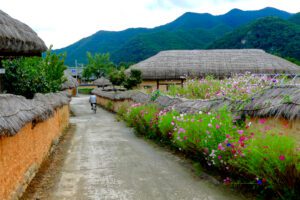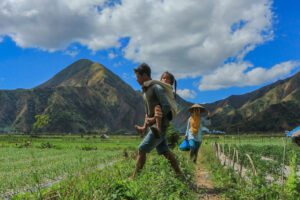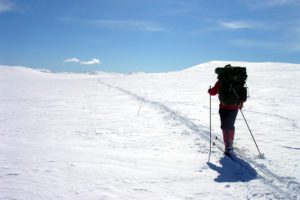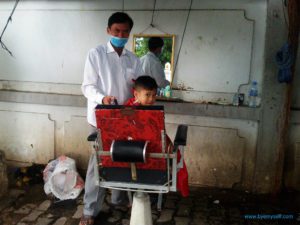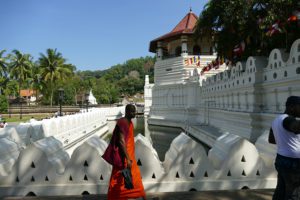BTS and Gangnam Style, Squid Games and Parasites – never before has South Korea been this hyped. Korean pop culture is not only on everyone’s lips, but also in everyone’s eyes and ears.
Time to join the hype?
Well, although everything Korean has become so incredibly popular, a first trip to Korea can be a challenge, especially for individual solo travellers who are not basically carried from place to place on a pre-organized tour.
Time to scratch your travel plan?
No way! In this post, I’m taking you on my first individual grand tour of Korea, the motherland of K-Pop, Kingdoms, and Kimchi. I’m by your side, supply you with much useful info, and warn you of some foolish rookie mistakes.
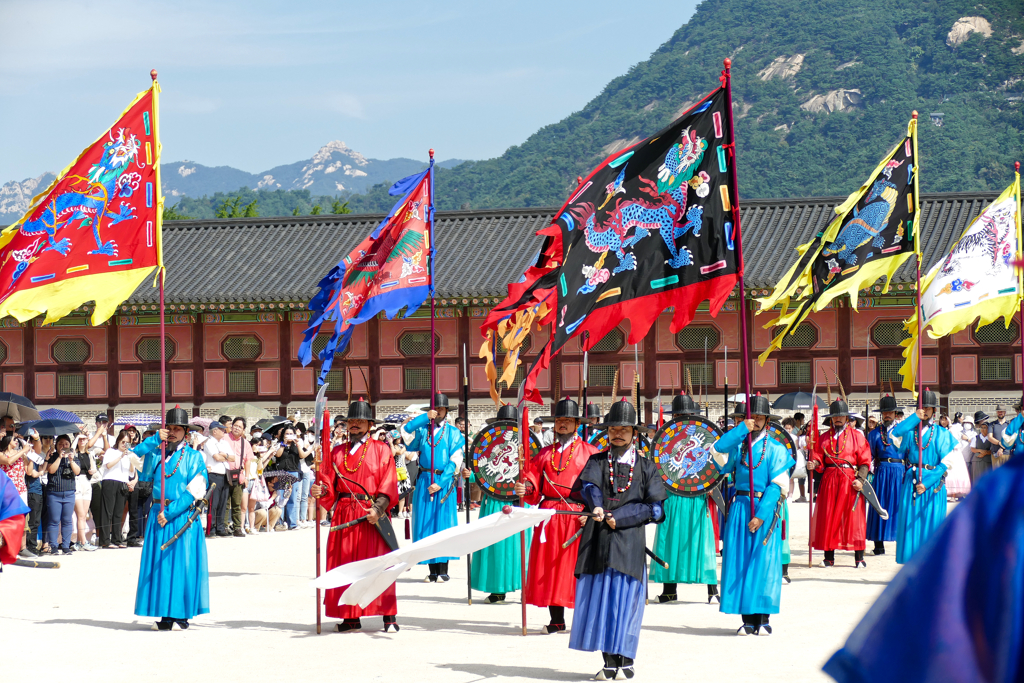
All this will make your trip to Korea easy and smooth and so much fun!
Hence, 한국에 오신 것을 환영합니다 – Welcome to South Korea!
A Quick Walk Through Korea’s History
In ye olden days, the three so-called empires of Korea ruled large parts of the Korean Peninsula and Manchuria until the 7th century, namely the Kingdoms of Goguryeo, Baekje, and Silla. The Kingdoms maintained close relations with their neighbors in China, Mongolia, Siberia, and Japan.

In 1392, Yi Song-Gye took over, and the Joseon Dynasty became Korea’s last and longest imperial Emperor. During the reign of the fourth King Sejong the Great, the Korean script Hangul was created in 1443.
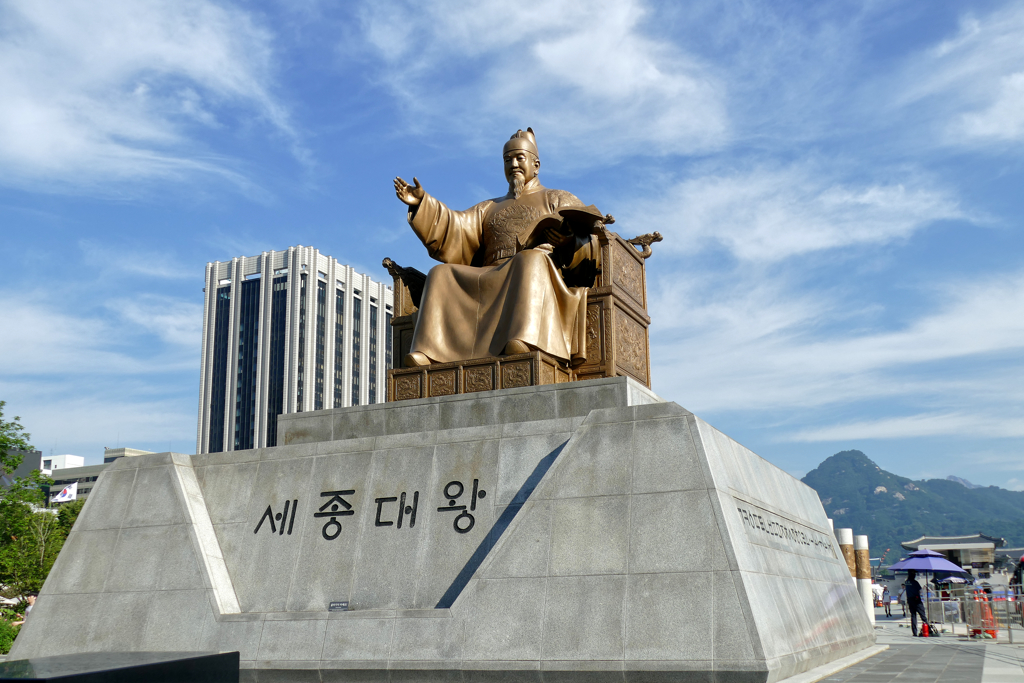
In 1905, Korea first became a protectorate of the Japanese Empire and eventually a colony in 1910. The Japanese oppressors banned the Korean language from schools and public offices in 1938. Also, in the course of their policy of cultural extermination, they excluded Korean courses from elementary education in 1941. As a matter of fact, the violence and humiliation that Korea had to endure during that period aren’t yet completely overcome to this day.
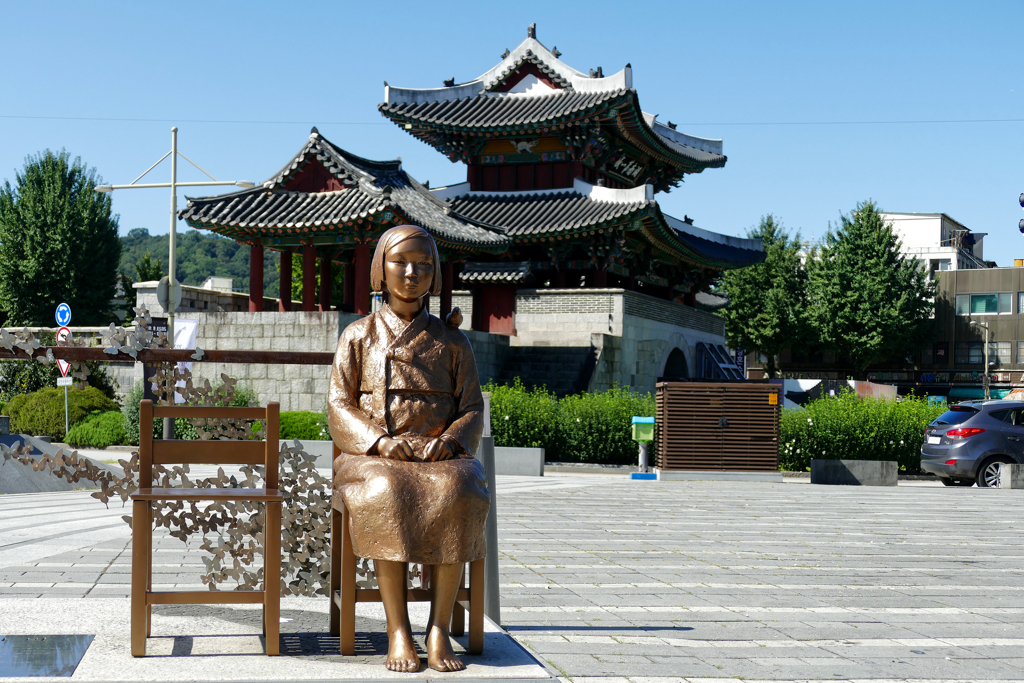
Particularly the crimes against humanity that the Japanese troops committed against the Koreans during WWII left deep scars, especially since Japan never acknowledged them to their full extent.
One People, Two Nations
After Japan’s defeat in WWII, the Allies occupied not only what is now Japan but also Korea. The two victorious powers divided the country along the 38th parallel. The former USSR took over the northern part while the USA administered the south.
In 1948, the occupying powers established independent Korean states on their territory and installed governments. The Soviet troops withdrew the same year and the US troops followed one year later. Both Korean states proclaimed sovereignty over the entire peninsula from the very beginning of their existence.
In June 1950, North Korea attempted unification by a military attack on the South. This resulted in a war in which a number of Western states took part. North Korea, on the other hand, was supported by the People’s Republic of China. After the armistice in July 1953, the division of the peninsula remained along the formerly defined demarcation line. A demilitarized zone was established around the demarcation line in accordance with the terms of the ceasefire.
Despite the heavily patrolled border between North Korea and South Korea, the people of both countries share a joint history, a mutual language, as well as cultural traditions.
Fun Fact
After WWII, Seoul became the capital of the Republic of Korea in 1945, obviously. However, North Korea’s constitution also specified the city as its capital. Only in 1972, a constitutional amendment defined Pyongyang as the capital of North Korea.
Note: If you are a history teacher, you might find this outline somewhat simplified. It is. Since this is mainly a travel post, the historical and political info is very basic and in places not complete.
Becoming an Asian Tiger
I guess everyone who doesn’t live in a shack in the woods has heard of the Korean War and knows that it is a divided country. But did you know that right after the war, the economy of North Korea was initially significantly stronger and far more advanced while the South was one of the world’s poorest countries? However, over the decades, the tables turned dramatically. While the North is basically collapsing, South Korea has experienced a fantastical economic boom since the 1970s. Today, it is one of the world’s twenty strongest economies. Companies like Samsung, LG, Kia, and Hyundai have secured the country a permanent place on the rich table of the global economy for many years. Then, successful cultural phenomena such as K-pop, K-drama, and, last but not least, Korean cuisine have been added in recent years. Today, Korea is considered a feast for all the senses.
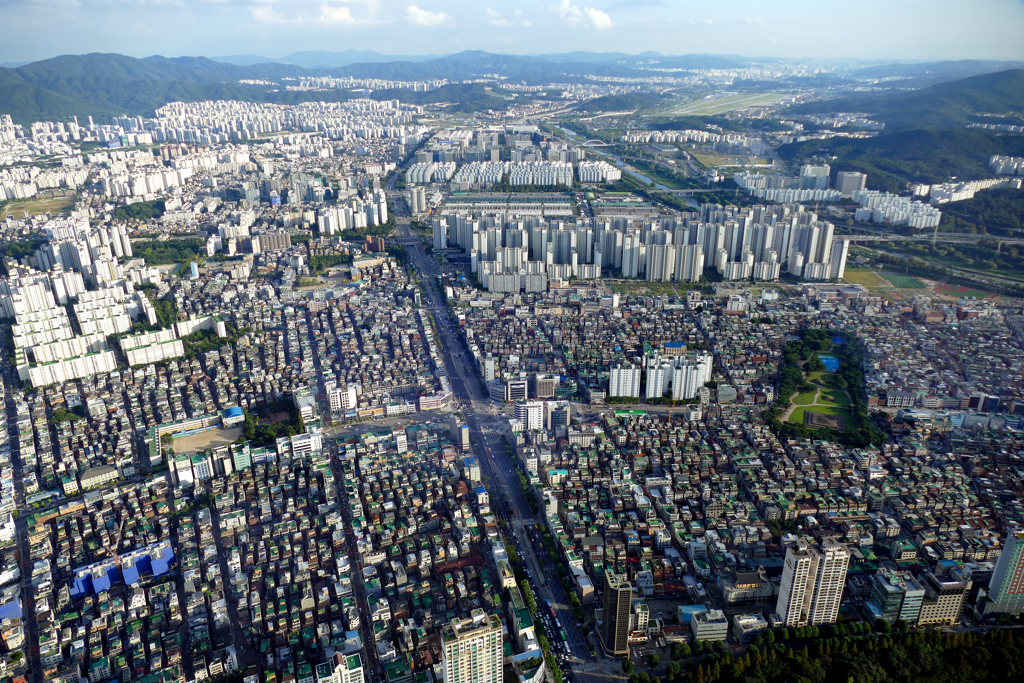
And even though I’m too old to have a crush on BTS and K-Dramas tend to get on my nerves, I thought it was definitely time to check out what this hype is all about.
Hence, time to travel to Korea.
Going Solo
Before I shower you with tons of information and tips, let’s take a look at what legends are spun about trips to Korea, which of them are true, and how the trip went for me as a Westerner and especially as a woman traveling alone.
Before the trip, I had of course done a bit of research into what to expect and how I should behave. I had been to Japan some time ago, and somehow I assumed that since Korea had developed economically in line with Japan, things might be similar in other areas too. And while some common courtesies such as taking off your shoes, keeping your voice down – especially not on public transport, and not blowing your nose loudly apply in both countries, Koreans tend to be more relaxed and not very strict. Young people are tattooed and pierced without being mistaken for mafia members. Korean cities are far from being dirty, but they aren’t that squeaky clean.
Overall, the vibe in Korea is not as aseptic as in Japan.
Law of the Urban Jungle
Koreans are nowhere near as reserved as Japanese. They may not shout around in the subway, but it is absolutely not taboo to chat and talk on the phone.
There are areas marked at the train stations that should remain free for letting passengers off the subway, and people stick to that. However, once they are on the train, all hell breaks loose. Yes, it is true that the marked disabled places are kept free for the elderly. Nevertheless, for all other seats, it’s the survival of the fittest. I’ve seen young girls quickly beeline their way past three grandmas to get the only available seat before them. Yes, the seat wasn’t designated for the old and weak, but still – how is that respectful?
By the way, there are also special seats for pregnant women on the trains. Interestingly, these are generally respected by non-pregnant women. But you wouldn’t believe how many pregnant men I’ve seen sitting there.
Yes, men in Korea take up a lot of space. It’s a man’s man’s man’s world. I didn’t just learn this from Korean YouTubers and Korean authors, I saw it with my own eyes.
It’s a Man’s World
And that brings us to the topic of female solo travel. Currently, Korea is taking measures to attract international visitors to the country. That’s why, for example, the K-ETA is currently suspended for citizens of 22 countries. That’s great, but foreign visitors are still far from being embraced by all Koreans. Westerners are aliens in Korea and are often viewed with skepticism. Mind you, Korea is a rather homogenous society with a rate of 3 percent foreigners of whom almost 50 percent are Chinese.
Nevertheless, in general, Koreans are friendly and helpful.
Yet, in Korea’s patriarchal society, a single woman is inherently strange, if not suspicious. After all, in Korea, the greatest good is to marry well and then give birth to a son as quickly as possible. In a country where the wife has to cook for and look after the entire family at her in-laws’ house on certain holidays, a woman travelling cross-country alone is an alien. How much Korean society is focused on men is shown, for example, by the fact that hotel saunas are only for men. Although I paid the same price, I was excluded from certain services based on gender. I know of several countries where the equal opportunities officer would investigate.
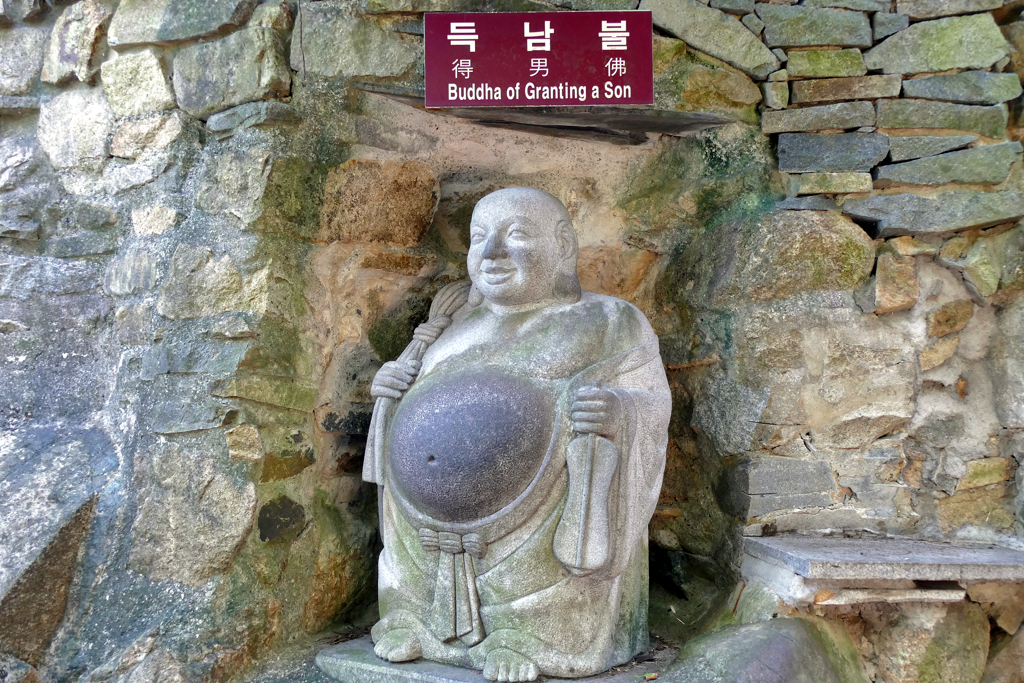
The sense of immense inequality is not just based on my gut feeling or humble experience: With 31 percent, Korea has the highest gender pay gap in the entire world!
Couples Only
As I said, Korea is a couple-oriented society. And that makes travelling solo more difficult. I have been refused service several times in restaurants with the argument that they only serve two or more people. While I can accept this at Korean barbecues, I still don’t understand why I was denied a fish platter in Andong.
Even certain attractions are designed for couples or families only.
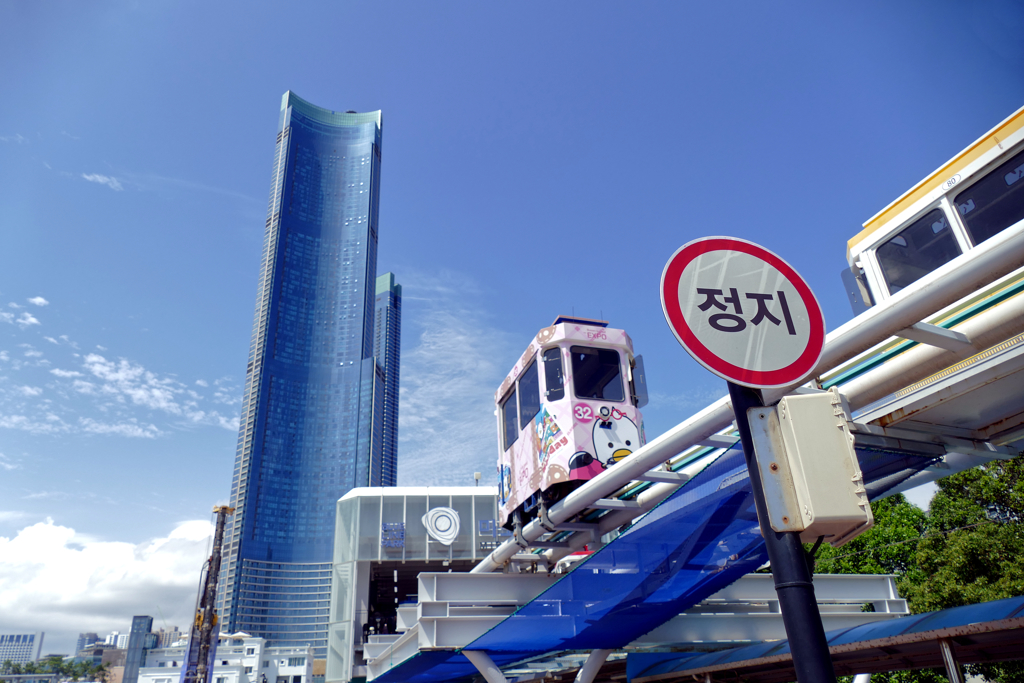
While this was at times frustrating and saddening, Korea has huge advantages for solo travellers: The country is incredibly safe. You can actually leave your luggage unattended for a moment to quickly grab a snack from the convenience store or go to the bathroom. You can walk back to your hotel after dark. Its safety makes traveling through Korea super pleasant.
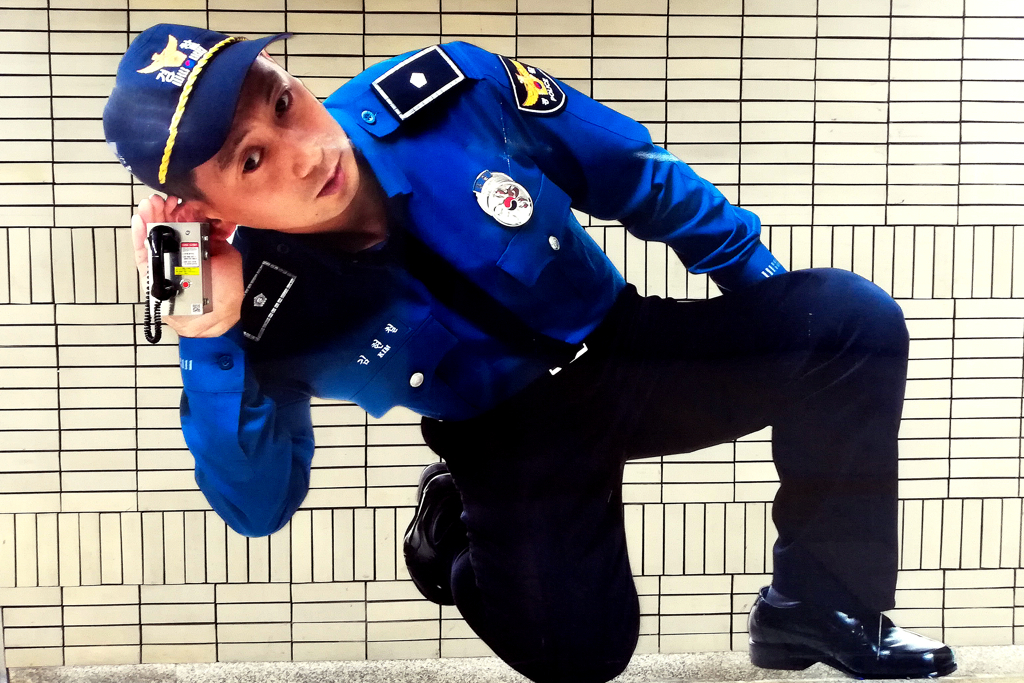
With my comments, I don’t want to throw dirt on the country and its people, but give solo travellers a realistic picture of what to expect.
However, to get an insight into Korean life, I recommend the books Kim Jiyoung, Born 1982 by Cho Nam-Joo, and The Vegetarian by Han Kang. Literature can be incredibly eye-opening in a country where you cannot communicate with the locals due to language barriers, but also cultural impediments. And no, those K-dramas might be entertaining and fuel your wanderlust, but they won’t give you a realistic perspective.
Lost In Translation
This brings me to the last point: The language barrier. Just as Japanese people only speak Japanese, Koreans only speak Korean. I’ve heard several times that this only applies to old people, that young people at least understand English. In my experience, this is not true, not even in Seoul or Busan. While old people don’t know English at all, young people know words. Single words. You can’t approach them with complex sentences. And I’m talking about young baristas in hip cafes. We communicated in one-word sentences.
Yes, I’m a savvy traveller and an avid travel blogger. And yet, before each and every trip, I’m a wreck. There are a million of what-ifs in my head and none of them has a happy outcome. And believe me, the prospect of going to a country where not only I cannot speak the language but I’m even not able to decipher a stop sign doesn’t make it better.
This being said, don’t be afraid of getting lost and never finding your way home. There is a reason why I wrote the post How to Surpass Pre-Travel Anxiety. I hope it calms your nerves and raises your spirits. Yet, I think I wrote it mainly for me, to calm my nerves, to raise my spirit.
Writing on the Wall
Considering the fact that people don’t speak English, it’s amazing how many signs are written in Roman script and English in addition to Hangul. In some subways and buses, the stops are even announced in English. So while you will unfortunately have to forego conversations with locals as much as possible, you will still get along without any problems.
Take it from me!
With a tiny bit of an adventurous spirit, a couple of helpful apps, and a big, big love for travel, South Korea is one of the countries that are easiest to travel – even as a female soloist.
Practical Information
How to Get There
Plane
South Korea is on a peninsula and borders on North Korea, obviously. The northern territory then borders on China and in the extreme northeast on Russia. Due to this peculiar layout, there are basically only two ways to enter the country: Either you fly in or you come via Japan by ferry.
There are 15 international airports in South Korea. Nevertheless, the vast majority of Western visitors land at the Incheon Airport about 55 kilometers west of Seoul.

After arrival, immigration is normally a piece of cake. Until the end of 2024, citizens of 22 countries don’t even need a K-ETA anymore. You can get all the information on touristy visits on K-ETA’s website.
Public transportation all over Korea is absolutely great, hence, you’ll find reasonably priced airport shuttles everywhere. I’m introducing the best connections in my post on the individual cities I visited.
Either way, I’d argue that there is no need to take a cab whatsoever.
Ferry
Due to Korea’s location and the country’s very peculiar political situation, the only alternative to entering Korea other than by plane is by ferry from Japan. During the pandemic, the ferry service was suspended, but is now running again.
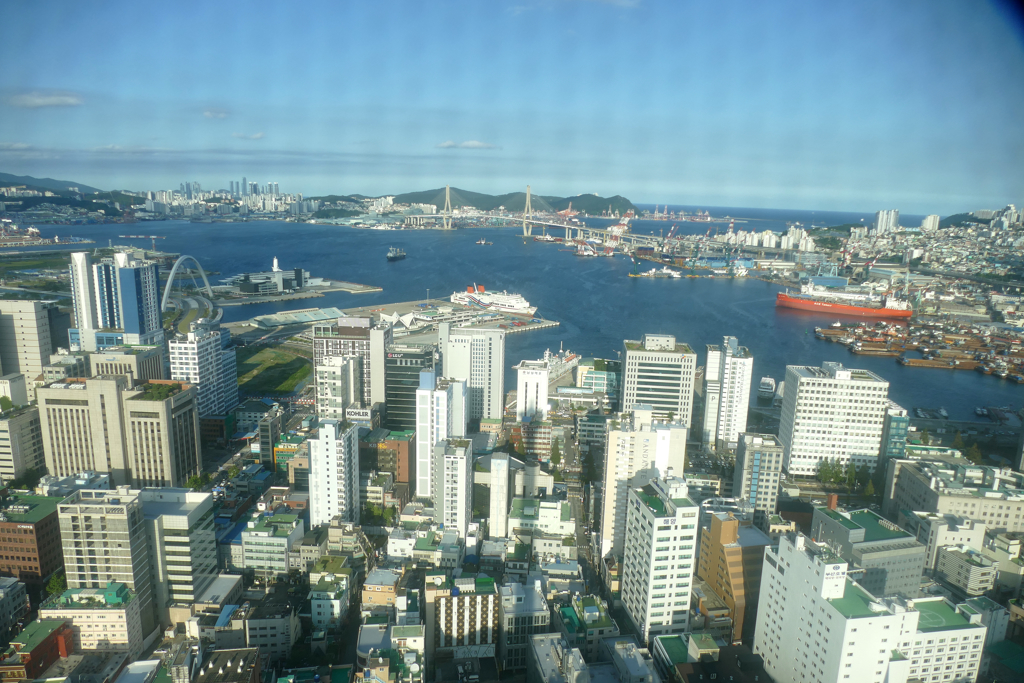
Ferries are going from Busan to Fukuoka as well as to Osaka.
How to Get Around
Train
Korean rail is mainly operated by government-owned corporation Korail. The fastest options are the bullet trains KTX as well as ITX.
You can buy tickets at the railway station from vending machines as well as real people and supposedly on the internet. Nevertheless, some fellow travellers told me that they couldn’t pay with their international credit cards. I don’t know since I always bought my tickets before departure at the station.
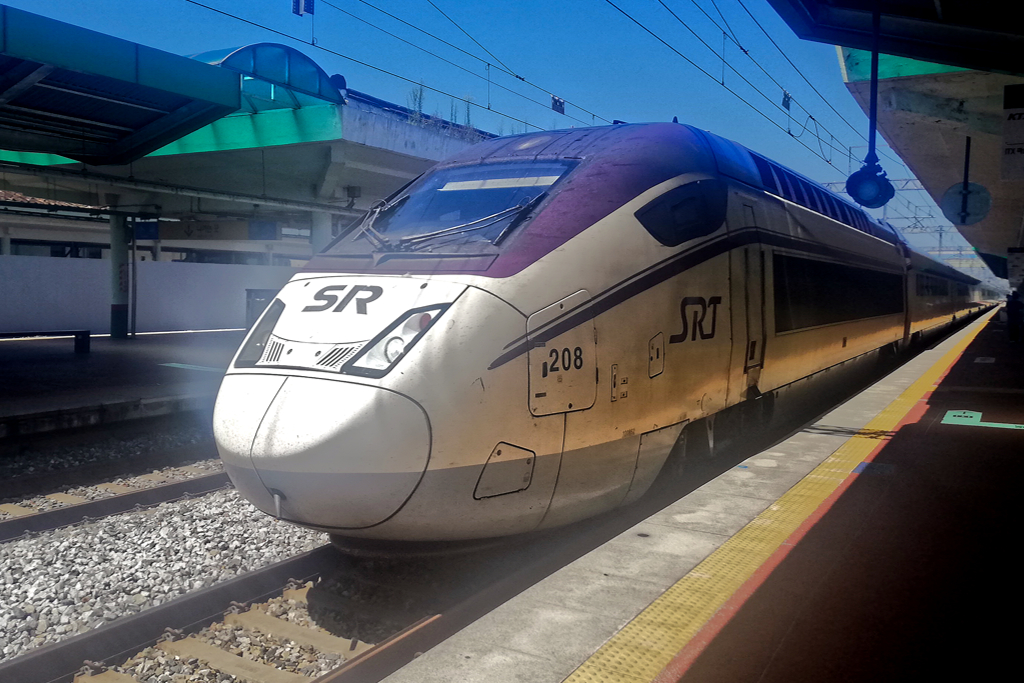
Obviously, train tickets cost just a fraction of airfare while trains like the KTX or SRT take you to some destinations in the same amount of time.
For the sake of completeness, it should be mentioned here that tourists can also obtain the KORAIL Pass. However, I cannot even imagine how much time you have to spend on those trains to get your money’s worth out of them. The cheapest pass costs KR₩ 121,000 for two consecutive days. In comparison, I paid KR₩ 21,000 for a KTX ticket all the way from Andong to Seoul.
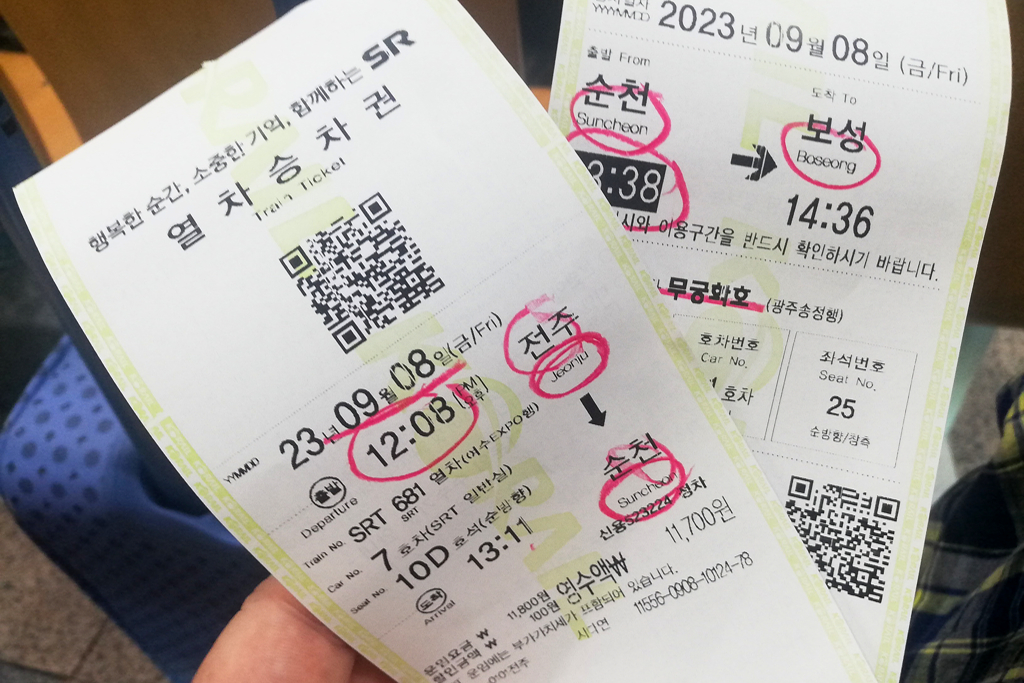
Yes, the good news is that KTX tickets can be quite cheap. The bad news is that it can happen that all seats are sold out. Does this mean you have to stand for hours?
Well, if you play it smart, you don’t.
Get Up, Stand Up – How to Survive a Standing Ticket on a KTX Train
So, what do you have to do to secure a seat?
First of all, boarded the train as early as possible. If your station is the railhead, be there about twenty minutes before the departure. In between the train carriages where the doors are, there are foldable seats that early birds can quickly grab and never let go.
You can also sit in one of the seats that remain vacant for some time as the passengers may only board the train at the following stations. However, you’ll have to give those seats up as the rightful seat owner boards the train.
Obviously, the standard seats are much more comfortable than the folding ones. However, there is a high risk of having to give them up again very soon.
When my train left Andong half-empty, it was very tempting to sit in one of those comfortable seats. But then I saw that the train would stop at seven stations before it reached Seoul. If I were evicted from my seat, my slightly more uncomfortable folding seat would have certainly been taken and I had to stand for the rest of the journey.
Bus
As a matter of fact, I took the train only twice during my entire three weeks in Korea as the bus stations were often more conveniently located. Also, I went to places where there were no train stations.
For travel between cities, towns, and villages, so-called Express and Intercity buses are a great option. They are fast, clean, and comfortable. Fares vary a bit depending on the bus type and the time of the day. However, in comparison with other countries, they are always rather cheap. I always paid KR₩ 10,000 to KR₩ 15,000 for four-hour trips.
You can buy tickets right at the bus terminals from vending machines or very helpful clerks. A shoutout to all the lovely ladies who recommended connections and explained to me what to do despite their lack of English.
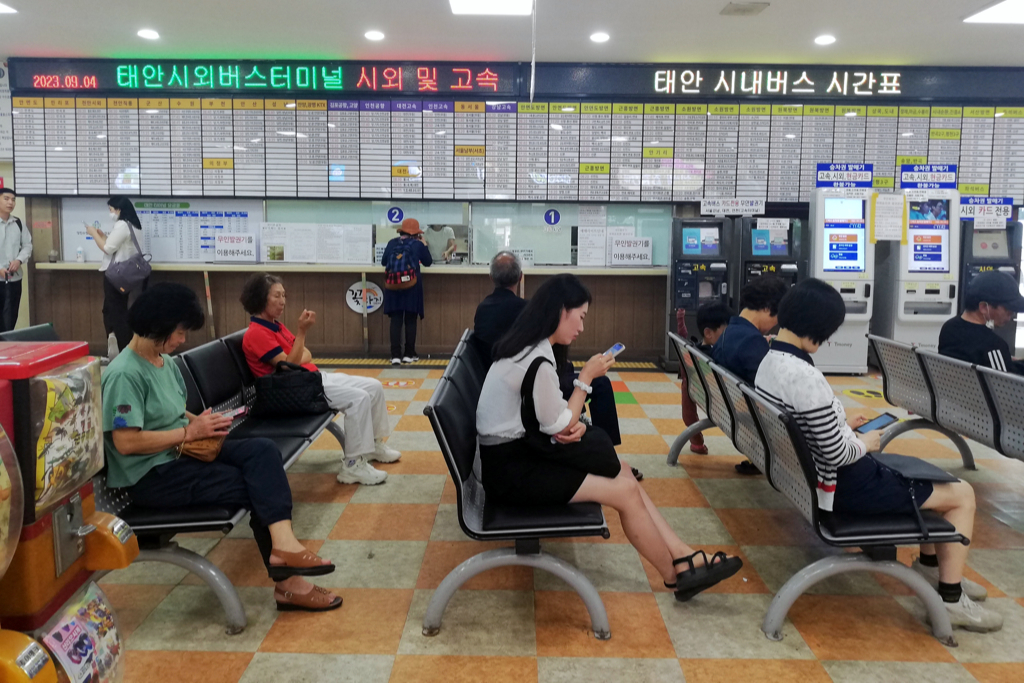
What you have to take into consideration is that there are different terminals for Express buses and Intercity buses. Most of the time, they are right next to each other which might be confusing. Also, in bigger cities, there are various terminals for different regions which are oftentimes located far away from one another. Therefore, double-check from which terminal your bus is leaving.
Inner-City Transport
Now, inner-city transport in Korea is bliss! There is a reliable bus service everywhere. A single trip costs about KR₩ 1,200 as you pay with your T-Money card.
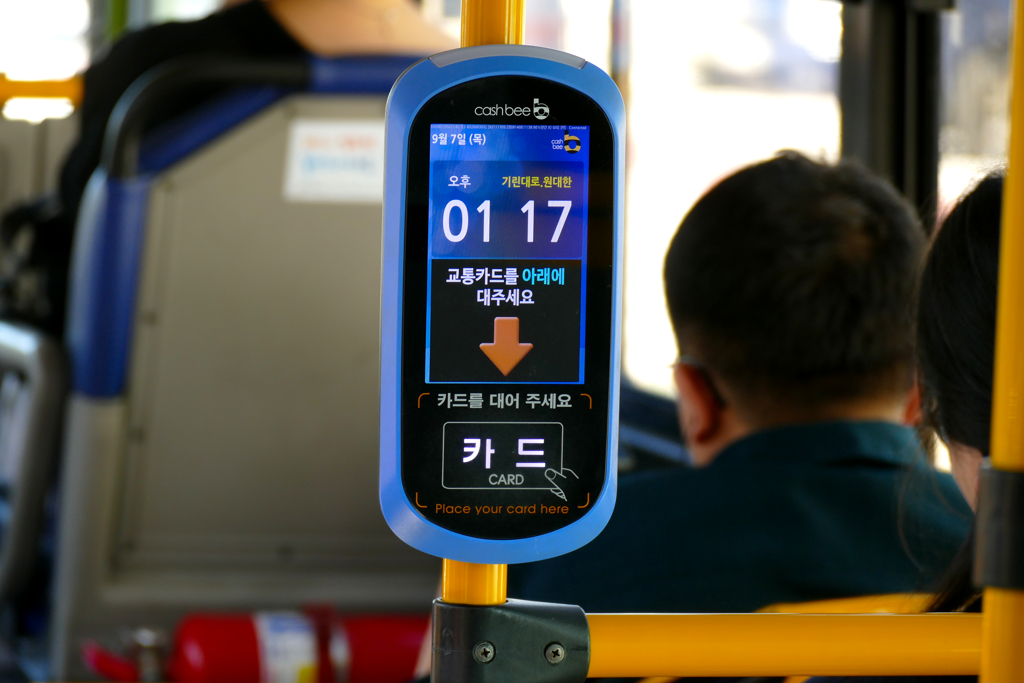
Seoul, Busan, Daegu, Daejeon, and Gwangju also have a subway system which is great and costs as little as a bus ride. However, don’t underestimate the size of Korean cities and the time you’ll spend on public transport.
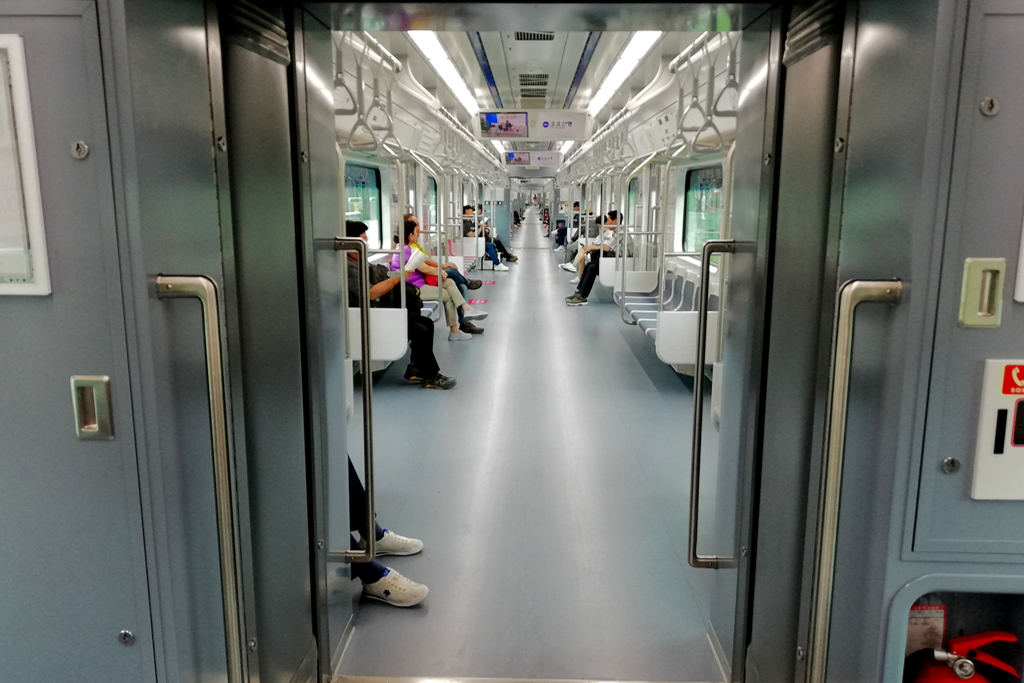
Also, during rush hour in the morning and in the late afternoon, the means of public transportation tend to get extremely crowded. You might want to consider this when planning your itineraries for the day.
Walking And Cycling
Since Korea is such a safe country, you can explore neighborhoods by walking without any trouble. However, as I mentioned above, cities are huge and distances much longer than they appear on Google or Naver maps. Don’t even think about exploring for instance Seoul’s or Busan’s city center exclusively by walking; take this from a traveller who easily walks around 20 kilometers per day when on the road.
Also, keep in mind that alluring parts of cities can be hilly with extremely steep slopes. Make sure to wear sensible shoes like Birkenstocks, trainers, or even light hiking boots.
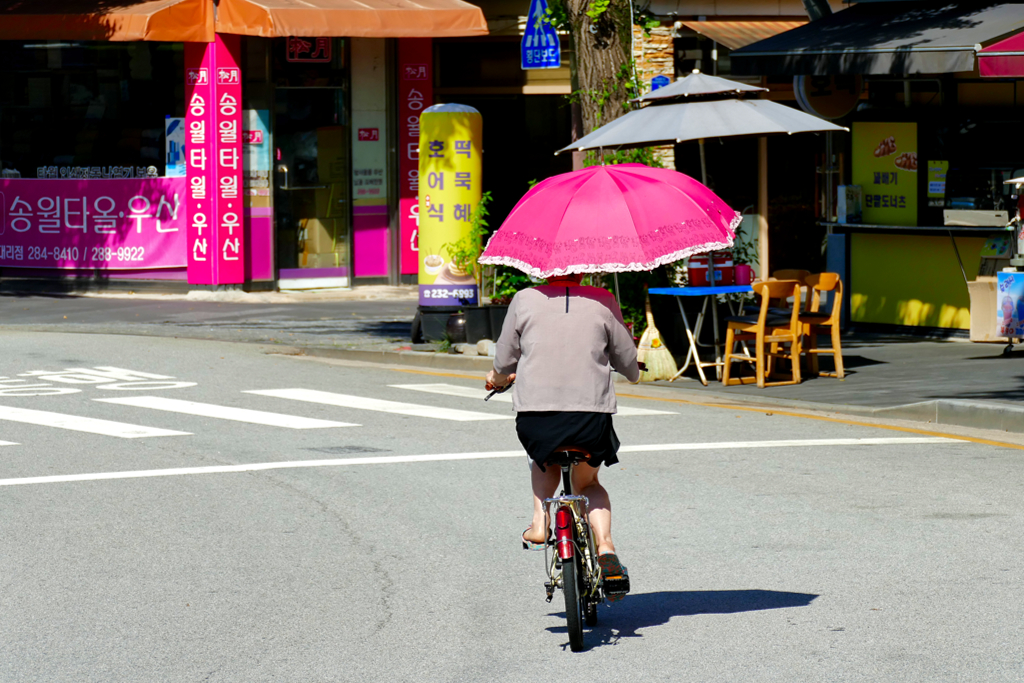
Obviously, in most places, you can also get around cycling. You’ll find detailed explanations of how to rent bicycles in my posts on the individual destinations.
Visiting Organized
Although I’m an avid solo-travelling woman, I sometimes like to join organized tours. Not only are they a valid option to go to remote places since I’m not driving. They also allow me to meet fellow travellers which is great, especially in a country like Korea where a solo traveller doesn’t get in touch with locals easily for cultural reasons and due to the language barrier.
Therefore, here are some great ideas of what to do when visiting Korea. Especially during high season, pre-booking online will guarantee your place at the activity of your choice**:
Where to Stay
Accommodation in Korea is plenty and in general reasonably priced. However, you’ll notice quite a difference between popular metropoles such as Seoul and Busan and places that are less frequented by international tourists.
Even when the furniture and the facilities are not the latest state-of-the-art, your room will always be squeaky clean. Other than in Japan, you won’t find pajamas at your disposal most of the time, but there will always be basic toiletries like body wash and shampoo.
Note that in some hotels, the shower will be connected to the faucet. There will be no basin or shower curtain, you will take your showers right in the bathroom. Therefore, you’ll always find a pair of plastic bathroom slippers so that you don’t need to walk on the wet floor after your shower.
Many hotels don’t offer a breakfast option, but you’ll always find a convenience store, a bakery, and a coffee shop nearby. However, at each and every accommodation, I had a small fridge where I got two bottles of water every day.
Below you can choose from a wide range of accommodations. You’ll find the hotels where I stayed and that I can recommend in the post on the cities I visited.
Since pre-booking is highly recommended, use this mask for your convenience when searching for suitable accommodation**:
What to Eat
Apart from Korean music’n’movies, the country’s cuisine seems to be taking the world by storm: In many areas of the world, Korean restaurants are springing up like mushrooms. And in Korea, tasty food can be found virtually everywhere: From vendors in the streets and in local markets to refined versions in posh restaurants. Many of these delicacies were invented over 2,000 years ago. However, some were only enjoyed by the royal families.
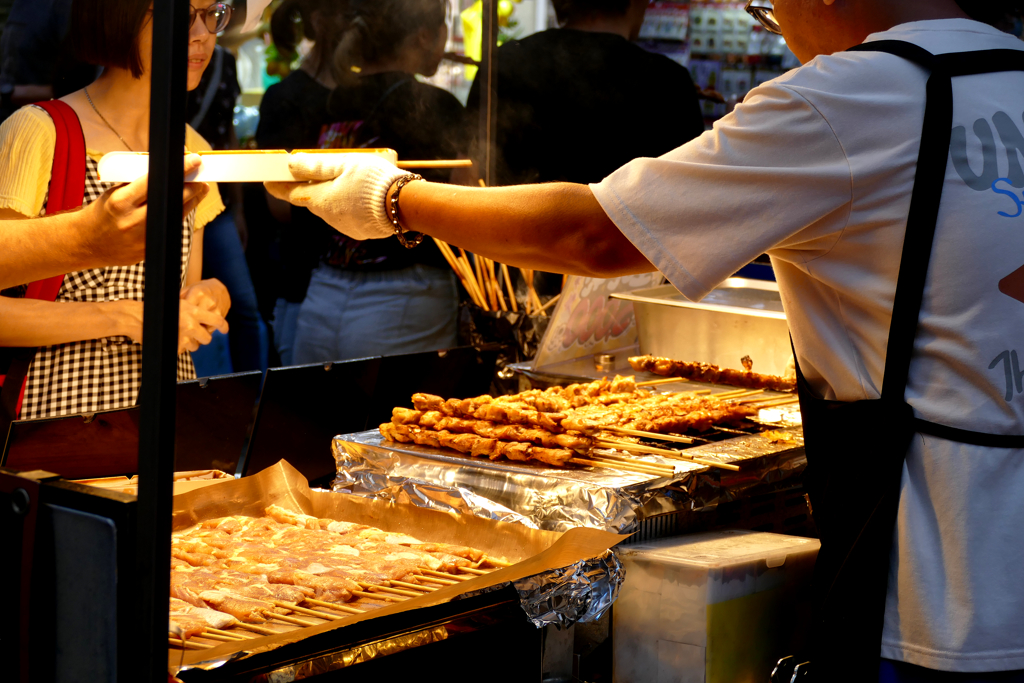
Korean food comes in many varieties as savory, spicy, hearty, and nutritious delights. Barbecue restaurants are very popular. There, various meat dishes are prepared right at the table.
In all modesty, I’m just listing the five dishes that you should definitely try – but there are many, many more waiting for you as Korea’s cuisine is so rich and varied. I’m introducing regional specialties in my posts on the individual destinations – like for instance Gyeongju‘s Ssambap or Gan-Godeungeo, which is salted mackerel, from Andong.
Bibimbap
Bibimbap is arguably Korea’s most popular dish. It’s made with rice and various vegetables like carrots, spinach, bean sprouts, and mushrooms. It can then be topped with beef, tofu, or fried eggs. Indispensable is a generous dash of Gochujang, a slightly spicy chili paste.
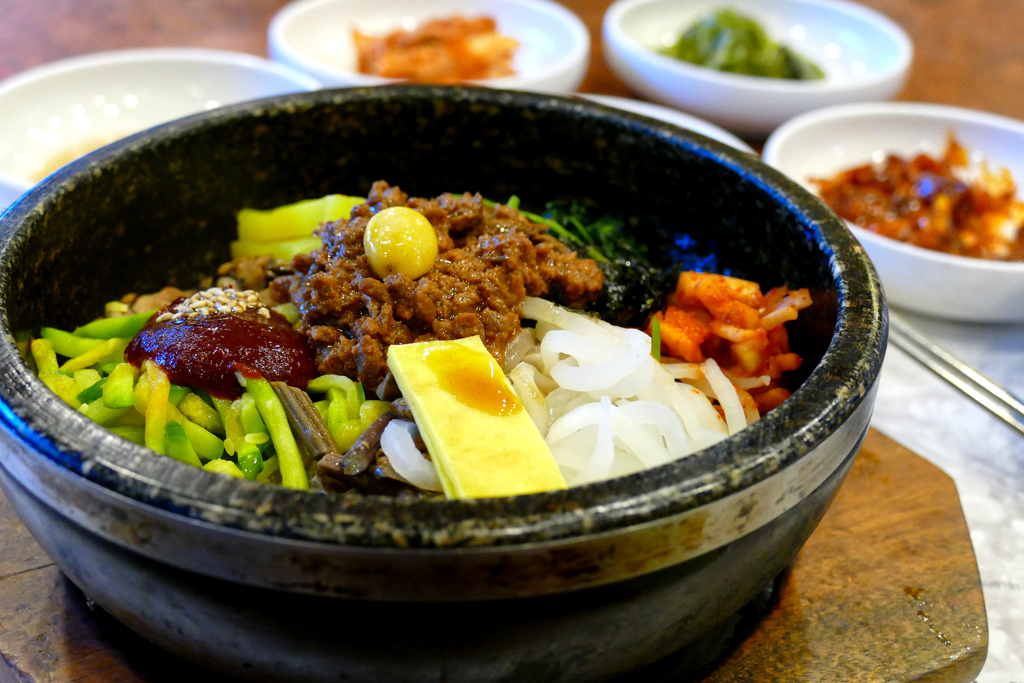
As the name derives from bibida, which translates to mix or stir, all the components have to be stirred together before eating although they are served unmixed. Bibimbap is served with a light bean sprout soup and comfortably eaten with a spoon.
Oh, this brings me to a crucial tip: If you wonder how to eat your food as the waiter didn’t bring you any utensils, just look in the drawer underneath your table. There you’ll find chopsticks, spoons, and serviettes.
Tteokbokki
Tteokbokki is a popular snack dish made from cylindrical rice cakes. They are usually seasoned with Gochujang, but often also with garlic and soy sauce.

The snack is pleasantly chewy yet very spicy.
Gimbap
Gimbap is very similar to Sushi, albeit you don’t dip it in Soy Sauce and sadly, you don’t eat pickled ginger with it. In Korea, it is a popular snack mostly eaten for lunch.
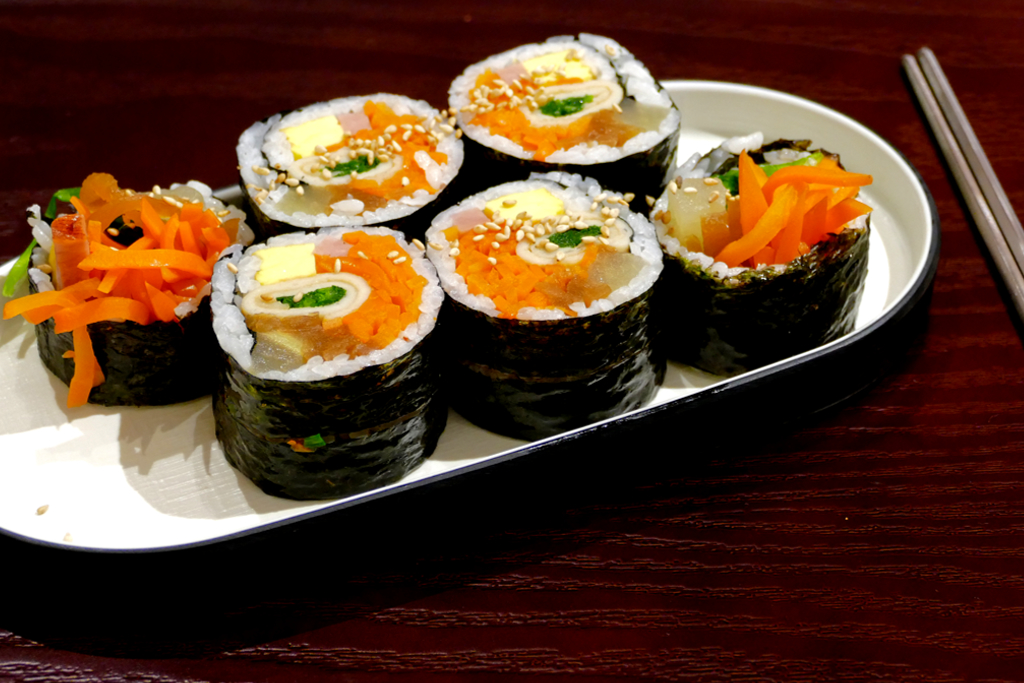
It always consists of Gim, dried purple seaweed, and Bap, hence cooked rice. Then, other ingredients in various combinations such as omelet, carrots, spinach, pickled radish, surimi, meat, or crab meat are added before the whole thing is wrapped in the shape of a log and cut into bite-sized pieces. These are eaten with chopsticks, obviously.
Bibim Nengmyun
Bibim Nengmyun is cold noodles served in a stainless steel bowl in a cold broth. Then, julienned cucumbers, slices of Korean pear, cold steamed beef, and a boiled egg are added.
The long and thin noodles are normally made from flour and buckwheat or sweet potatoes. However, there are variations of pasta made from seaweed and even green tea.
Chimaek
Yes, you can eat fried chicken basically anywhere around the globe. However, Korean fried chicken takes it to a whole different level. The chicken is coated with a sweet and spicy sauce before double frying it in vegetable oil.
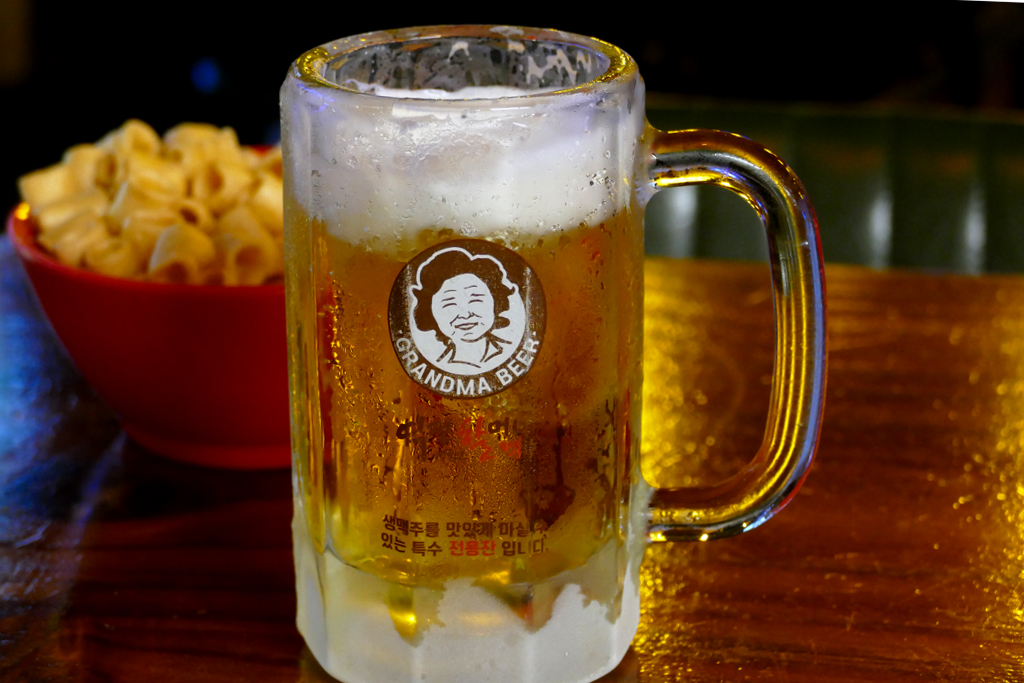
Therefore, the meat remains very juicy while the lightly battered skin is crunchy without being too greasy.
It is mostly a popular late-night snack and is typically washed down with ice-cold beer.
Banchan
Banchan are the most important staple of Korean cuisine. They are a variety of different vegetable dishes served in small bowls. Those are placed in the middle of the table for everyone to enjoy. In some restaurants, you can choose the Banchan you like from an open buffet.
The most famous Banchan is probably Kimchi. Kimchi is fermented vegetables – traditionally Chinese cabbage and Korean radish. Together with rice and a light soup, Kimchi is an essential part of practically every meal in Korea.
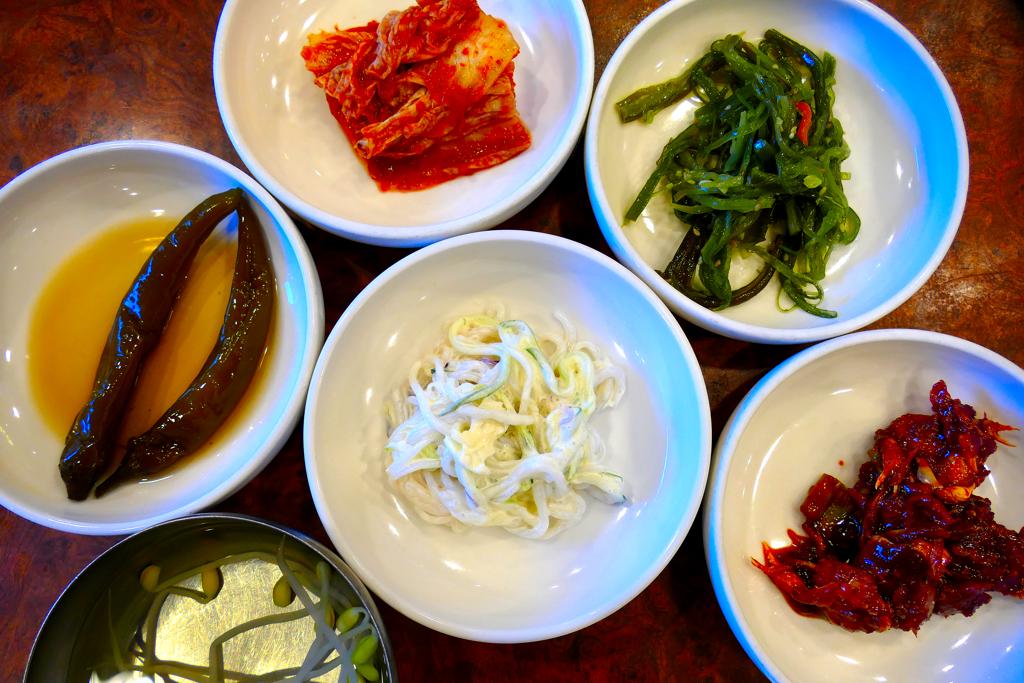
As basically all types of vegetables can be fermented, additional types of kimchi have emerged. Apart from cabbage and radish, you’ll be served also cucumbers, leeks, and some local roots. In 2013, Gimjang, the traditional process of preparation and preservation of Kimchi, was added to the UNESCO list of Intangible Cultural Heritage.
Fun Fact:
12 different kinds of Banchan were the standard at the Royal court
Connection and Communication
In Korea, you can connect to the internet without any issue at basically every museum, eatery, café, and your hotel, obviously, as well as to open Wi-Fi in many public areas.
As I depended so much on a reliable internet connection during my trip through Korea, I highly recommend getting your personal data either by a mobile router or a local SIM card. I kid you not, the few moments I for some reason didn’t have an internet connection, I felt like travelling blindfolded.

There are prepaid SIM cards by various companies such as KT Corporation, SK Telecom, and LG U+. I got my card from the latter and loved it. LG U+ offers SIM cards, eSIM, as well as portable Wi-Fi. My card came with a T-money that I obtained through GetYourGuide* and picked up at Incheon International Airport on arrival. For unlimited data, they charge between KR₩ 27,500 for 5 days and KR₩ 99,000 for 40 days. I had the 20 days-version for KR₩ 60,500*.
In South Korea, they use plug types C and F. Their voltage is 220 V, and the frequency is 60 Hz. Whereby, nowadays, in general, all these chargers have integrated adapters so that the voltage and frequency don’t really matter.
By the way, you’ll find this information and many more comprehensive travel tips in my post World’s Most Complete Travel Information – an indispensable globetrotter-classic.
Useful Apps
So now that you have internet, you might want to check out these helpful apps. Well, let me rephrase it: At least a smoothly working map and a translation app are not just helpful, they are actually indispensable!
Naver Map
It’s not correct that Google Maps doesn’t work in Korea at all. You can open the App and see where places are. However, it doesn’t give you useful information on public transport and it doesn’t suggest routes. Yet, it recognizes who you are: The blue dot. So while you can check where you are, you cannot plan out routes.
Fortunately, there are two other Apps in Korea, namely Kakao Map and Naver Map. Since I had tried out the latter and was happy with it, I stuck with it without giving Kakao Map a try.
How to Use It
As you can see in the pictures below, Naver works basically just like Google Maps: You type in from where to where you want to go, specify the date and hour, and choose the means of transportation. Then, Naver does the magic and suggests various options.
However, Naver tends to be patriotic and sometimes transcribes destinations into Hangul so you cannot check that it actually found the place you were looking for. I solved this problem by verifying Naver’s suggestion on Google Maps.
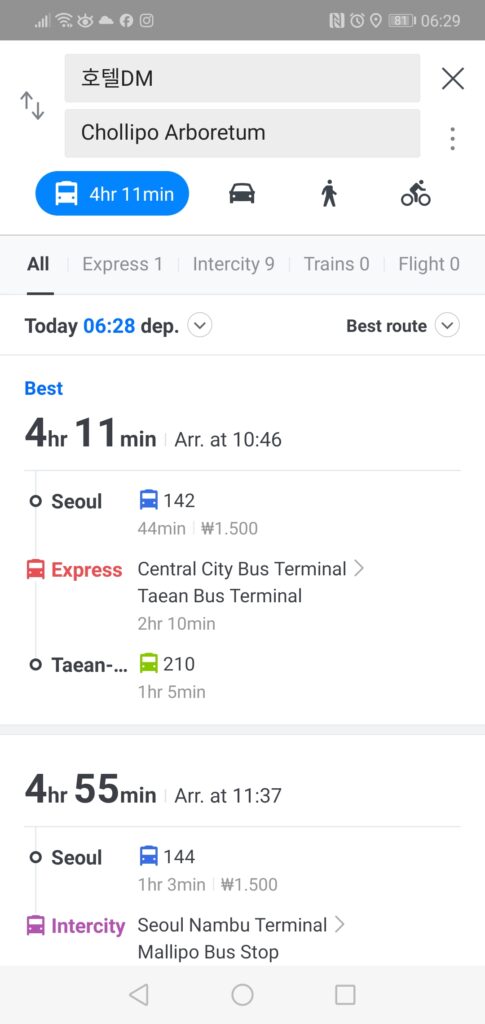
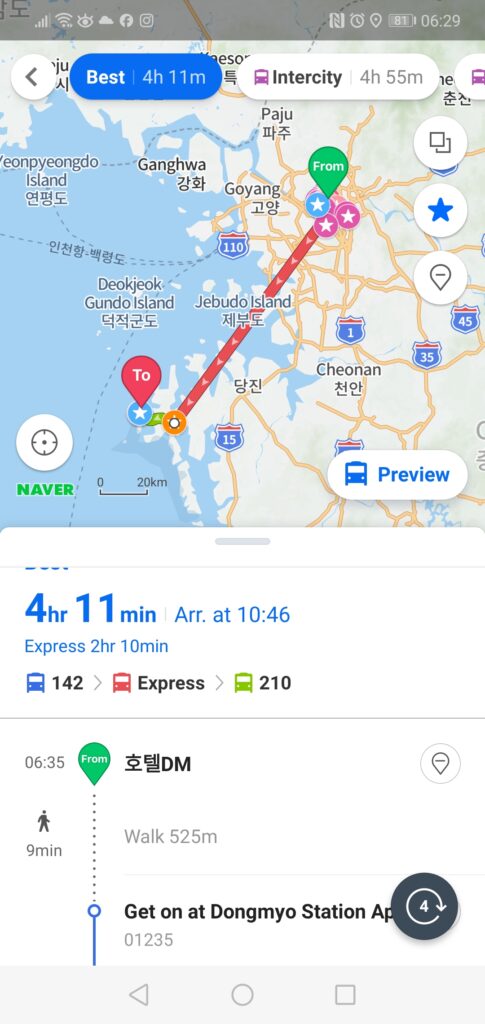
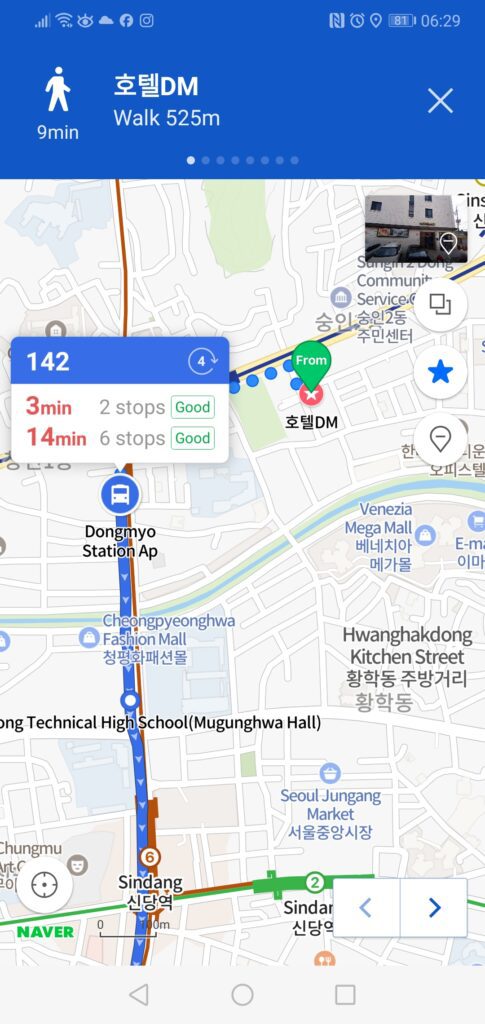
Also, Naver sometimes didn’t show any search results. For instance, if I wrote XYZ restaurant instead of restaurant XYZ. In these situations, I first looked it up on Google Maps, because like I said, it does work insofar as it finds places. Then, I searched for the spot right on Naver’s map. As I found it, I tapped on it on the screen and saved the result for future reference.
Registration Recommended
I set up a free account to save search results. I organized them in folders, you can see them in the second picture.
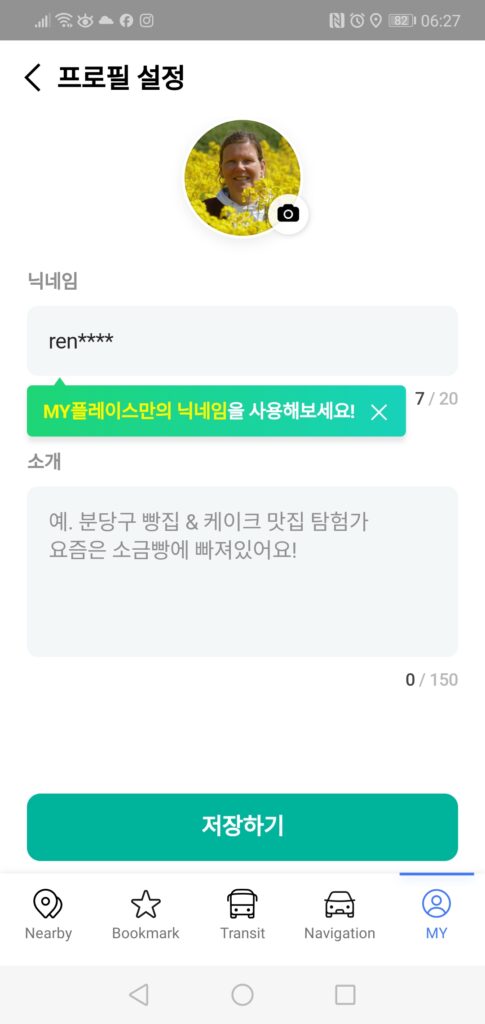

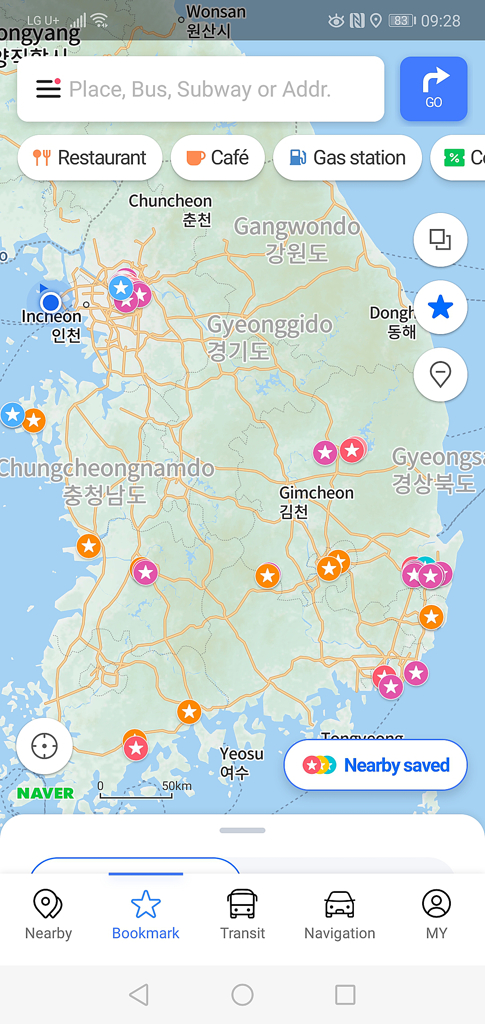
When Naver showed the result in Hangul, I wrote the Latin equivalent in the field for notes before saving. This way, I had the places once and for all in Roman letters, and they also appeared on the map. Eventually, I planned my routes by simply tapping on two marked spots on the map.
You can download the Naver App for Android and for iOS
Microsoft Translator or Naver Papago
Just like it’s a personal preference if you search your way with the help of Naver Map or Kakao Map, it’s totally up to you which translation App you’re using. And even if you don’t choose any of these, most Koreans do have a translator on their phone when they have to deal with foreigners on a regular basis.
For the same reason I chose Naver Map over Kakao Map, I stuck with the Microsoft Translator: I downloaded it first and was happy with it – hence, never change a winning team.
However, both translation Apps offer the same kind of assistance: You can speak, write, or take a picture of a script and the App will translate it.
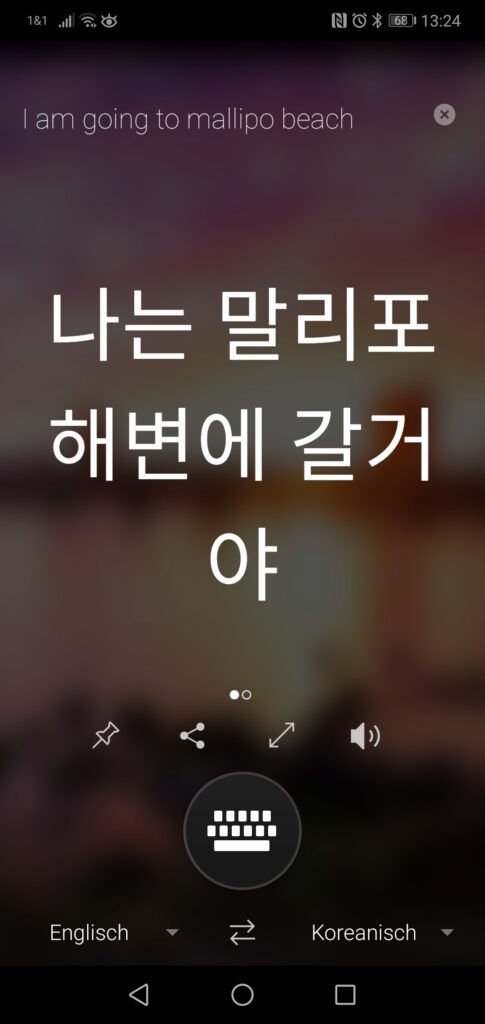

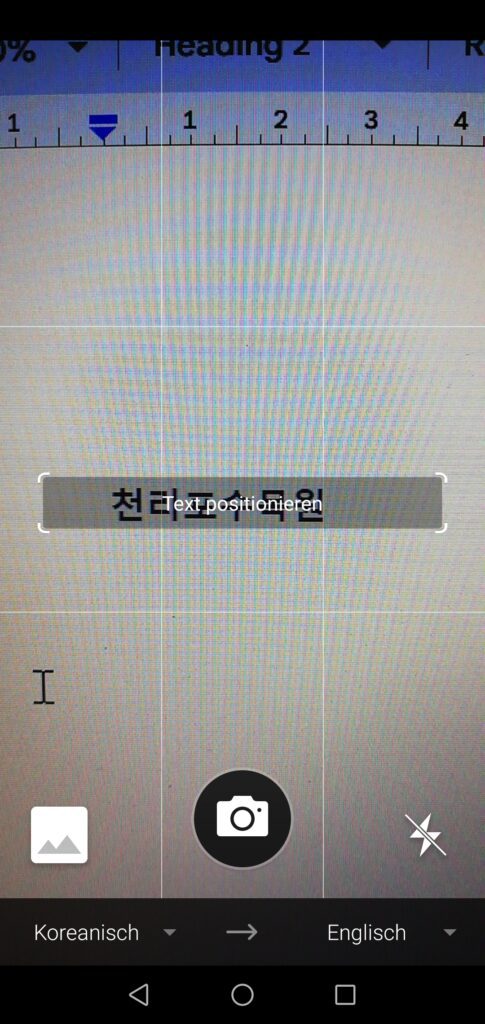
You can download the Microsoft Translator for Android and iOS.
Xe Currency Exchange
Because of its user-friendly operation and quick and easy access to all national currencies, Xe is my favorite currency converter app. You can download it for Android.
Cash And Cards
Talking ’bout money: The currency in Korea is called ₩on and abbreviated KR₩. There are bills of 1,000, 5,000, 10,000, and 50,000 and coins of 10, 100, and 500 ₩on.
As of December 2023, the exchange rate is 1,000 KR₩ = 0.75 US $ (current rate) respectively 1,000 KR₩ = 0.70 €uro (current rate).
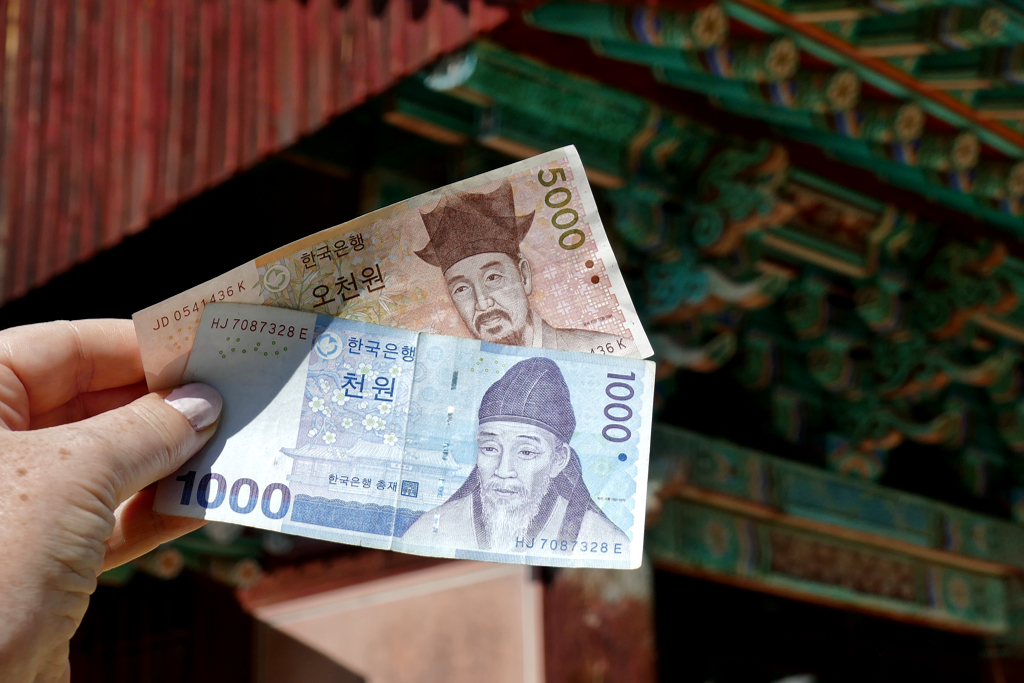
Most of the time, you can pay with either cash or card in Korea. However, some businesses accept only cash while others take only cards. Although payment goes smoothly most of the time, you might encounter some hurdles here and there.
In Korea, they draw a not-so-fine line between local cards and international cards.
Therefore, it can happen that certain readers are only suitable for cards issued in Korea. More importantly, you can get only money from ATMs that are suitable for so-called global credit cards.
Either way, it’s recommended to have always at least a small amount of cash on you as international cards may decline for no apparent reason.
T-Money Card
A very Korean means of payment is the so-called T-Money Card. It’s basically a debit card that you have to purchase for an initial price of KR₩ 2,500. You can get the basic T-Money Card at any subway- and train station as well as at convenience stores around the country. However, you can get a free card for instance when buying a SIM Card* or obtaining a Discover Seoul Pass*.
Eventually, you have to charge it with the amount of your choice either at a ticket vending machine or a convenience store. You can top-up the card in units of KR₩ 1,000 up to KR₩ 90,000 at a time. The total deposit cannot exceed KR₩ 500,000. It’s important to know that you cannot top-up by credit card, you have to use cash. Also, I’d recommend topping it up with smaller amounts in case you lose it.
If you don’t use up the credit on your card by the end of your trip, you get a refund at all retail locations. However, they won’t refund the initial price as well as an additional service fee of KR₩ 500.
As I needed both, a SIM card and T-money, I obtained a combined card through GetYourGuide* and picked it up at Incheon International Airport on arrival. Obviously, you can use the T-Money card even after the SIM card expires.
Language
With over 78 million native speakers, Korean is one of the 25 most spoken languages in the world. And let me tell you, it’s basically all Koreans do speak. I was told only the older generation wouldn’t speak any English, young people would. According to my experience in roughly a dozen places in Korea – from big cities to hidden beach destinations – this is not the case. Contrary to older people, young Koreans know some English words. That doesn’t make them English speakers even of a rudimentary kind.
But fear you not, streets, stations, and many signs are written in English, so you won’t get lost. In Seoul’s subway and in many buses the stops are also announced in English. Some restaurants do have English menus, however, when you order the dish, the waiting person might not understand what you want unless you point at the Korean version. Happened to me on various occasions.
All this makes travelling through Korea possible even if you don’t speak the language and you’re not familiar with Hangul, the Korean alphabet. But your interaction with locals will remain extremely limited, to say the least.
Howsoever, I recommend memorizing at least this short list of some of the most common courtesy expressions:
| English | Korean | Pronunciation |
| Hello | annyeonghaseyo | anyonghaseo |
| Bye bye | annyonggiseo | anyonggiso |
| Thank you | gamsahamnida | kamsamida |
| You’re welcome | cheonmaneyo | chonmaneo |
| Please | juseyo | djuso |
| Excuse me | jeogiyo | djokiyo |
| Sorry | joesonghamnida | djusohamida |
| Yes | ne or ye | ne resp. ye |
| No | aniyo | anyo |
My tip regarding pronunciation:
Korean is pronounced rather softly. That means that G is pronounced like K, D like T, and B like P. Also, S before I is pronounced Sh.
I’m telling you this so you avoid mispronunciation of cities and places and get what people are talking about when they say Kyongju instead of Gyeongju, Teagu instead of Deagu, and Pusan instead of Busan.
If you actually want to learn some more, I can highly recommend the website 90 Day Korean.
This Is the Route I Travelled
These Are the Places I Visited
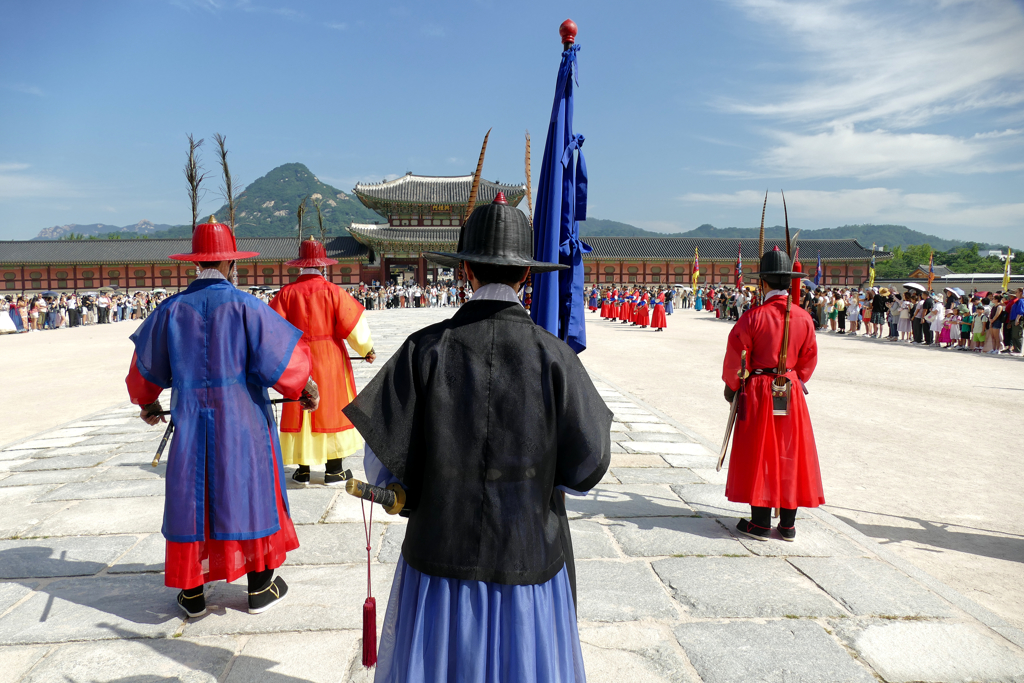
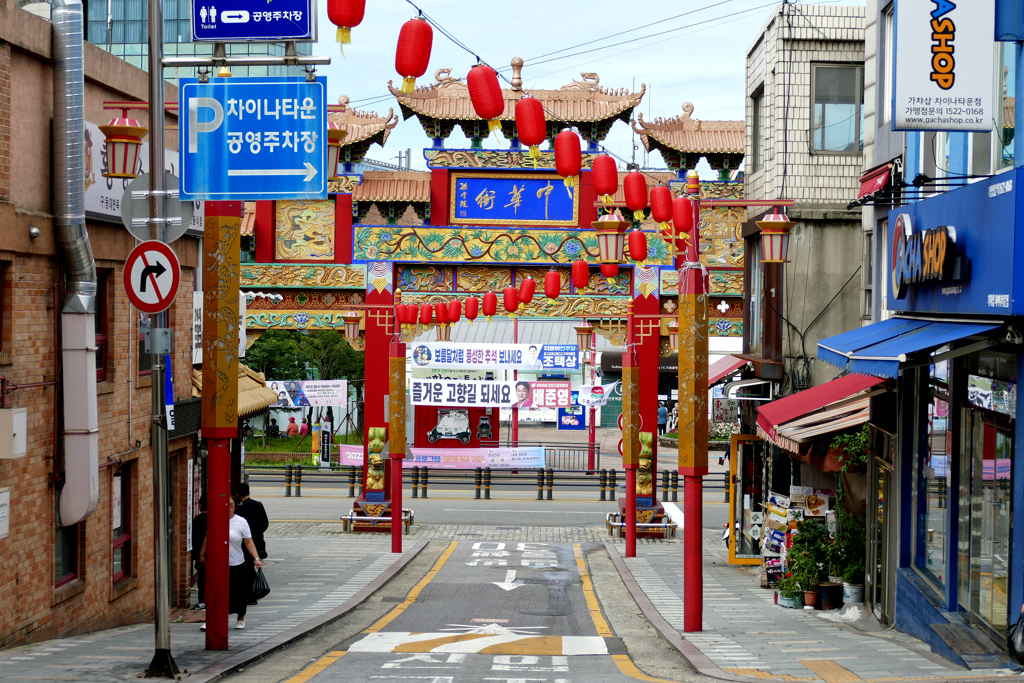

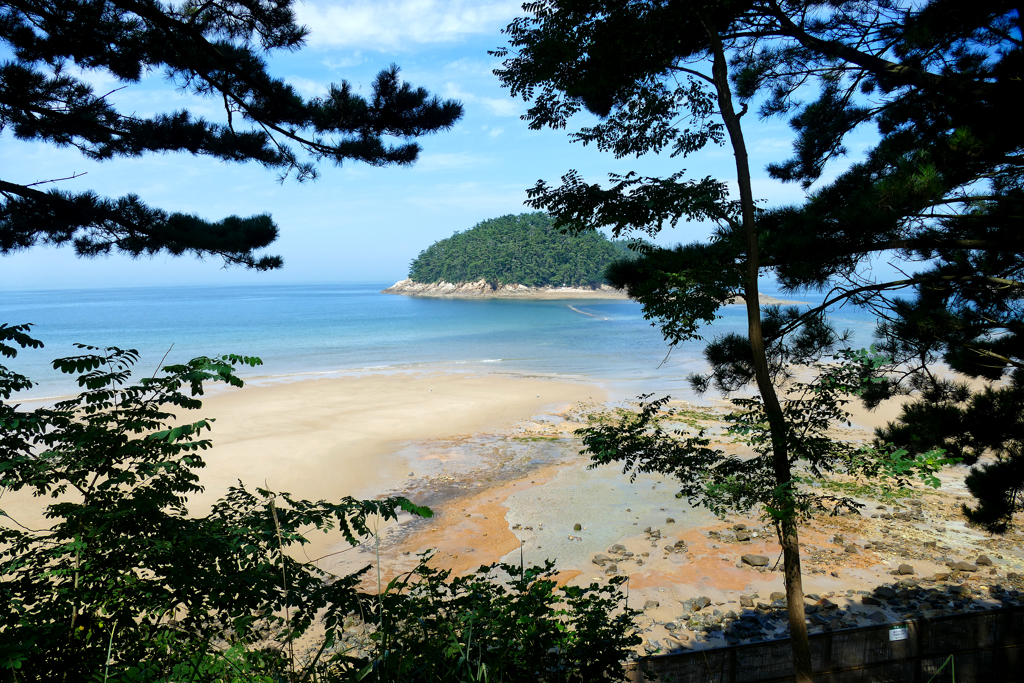
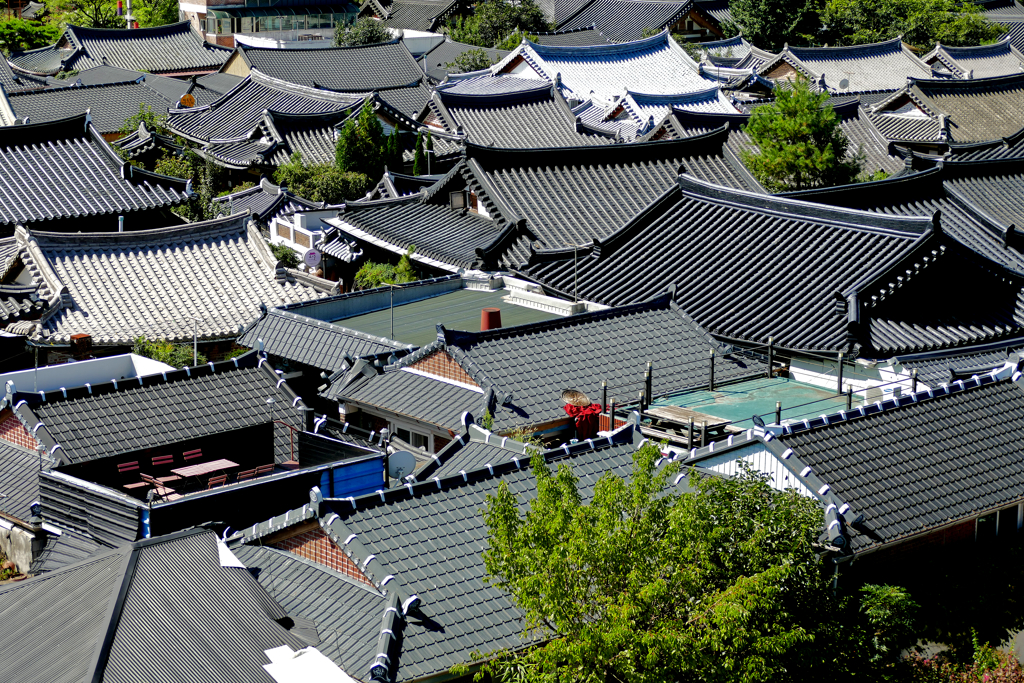
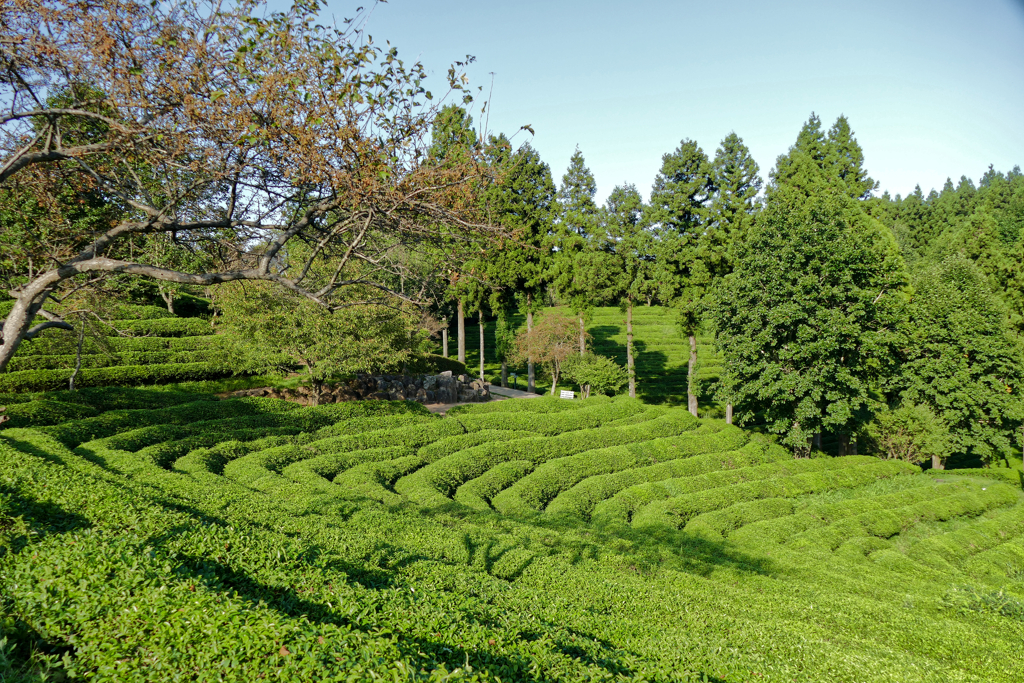

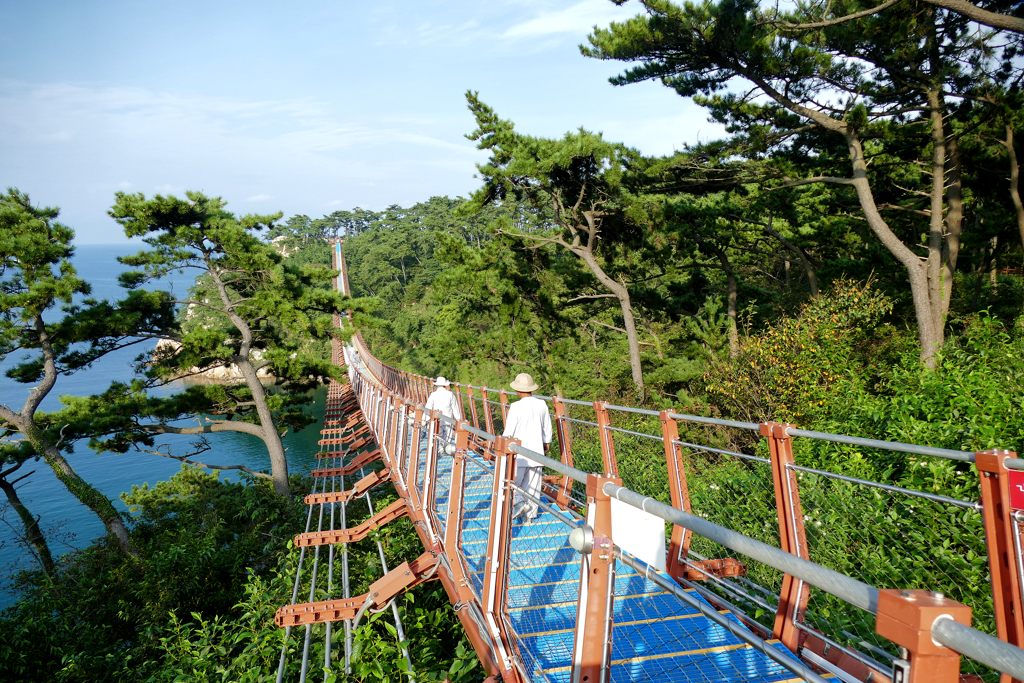

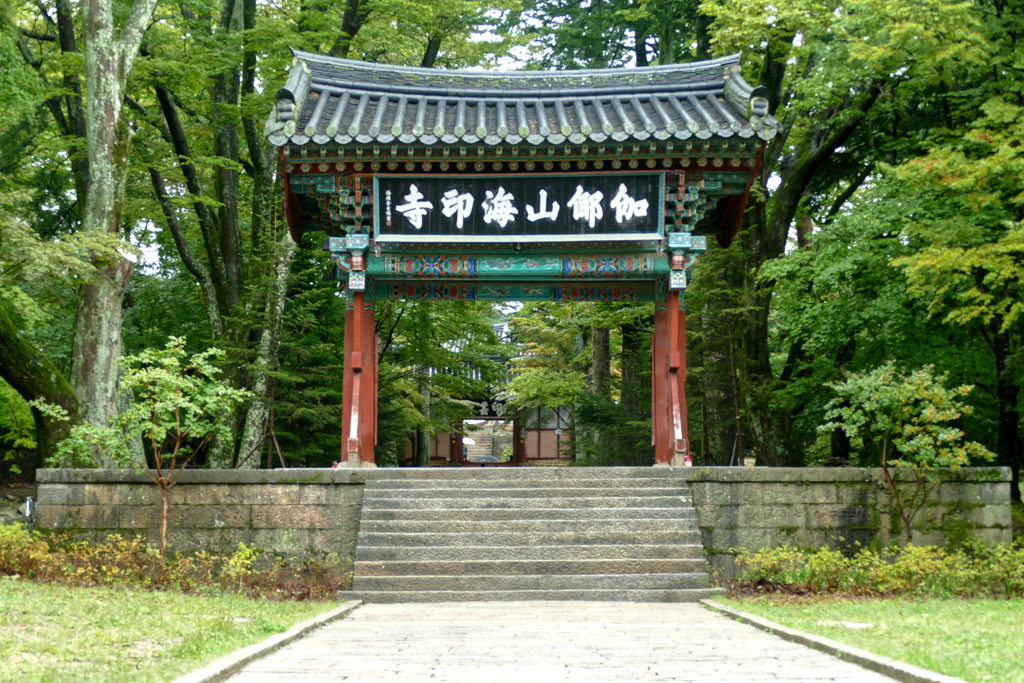
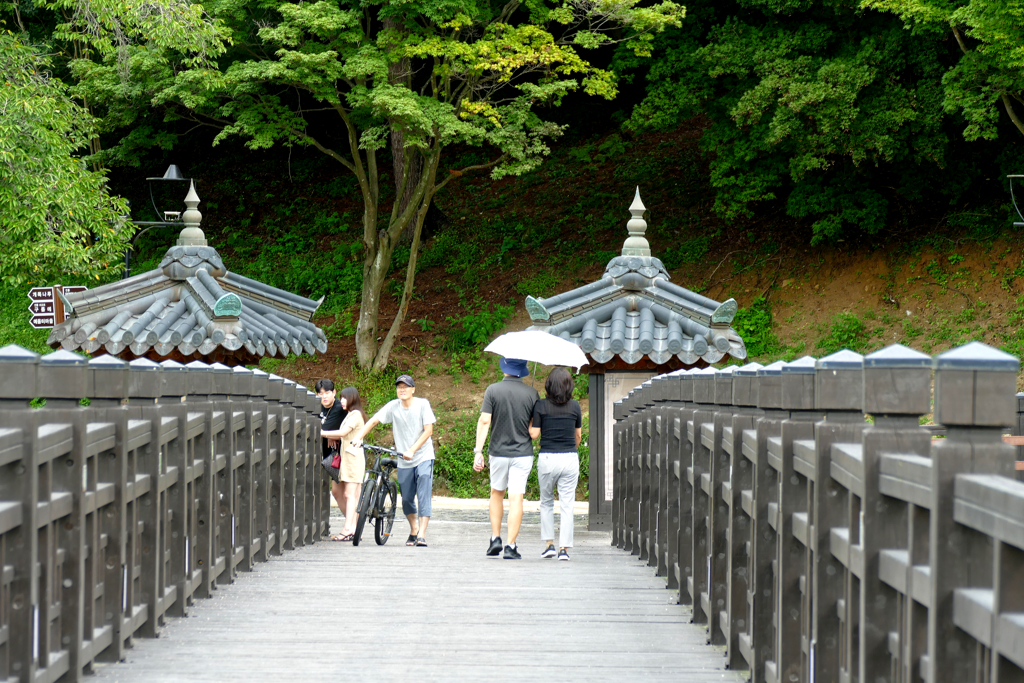
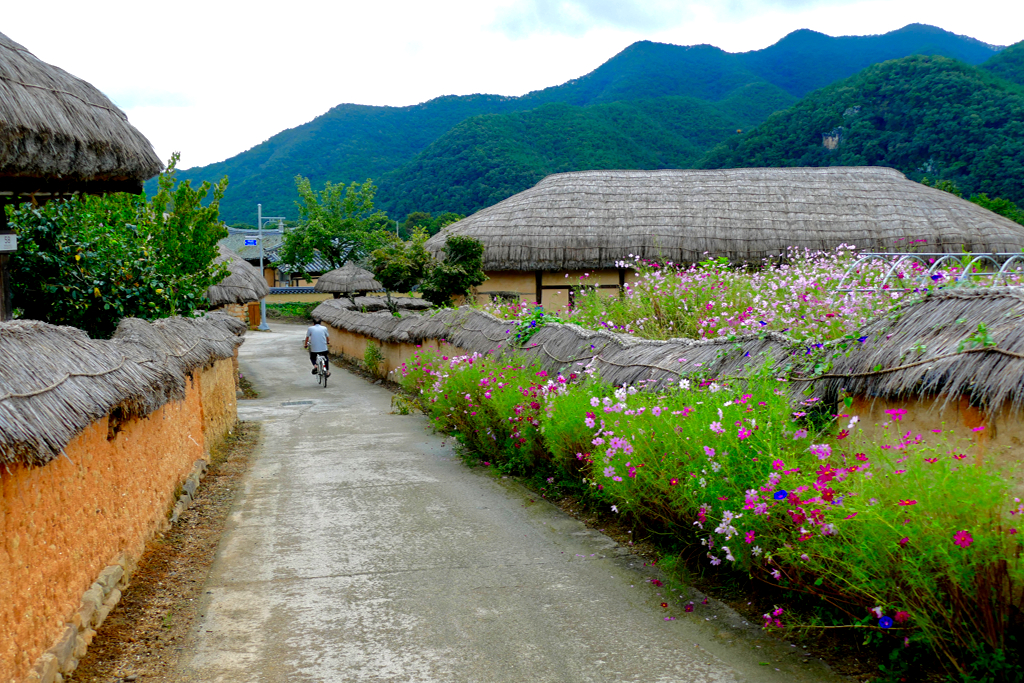
Pinnable Pictures
If you choose to pin this post for later, please use one of these pictures:
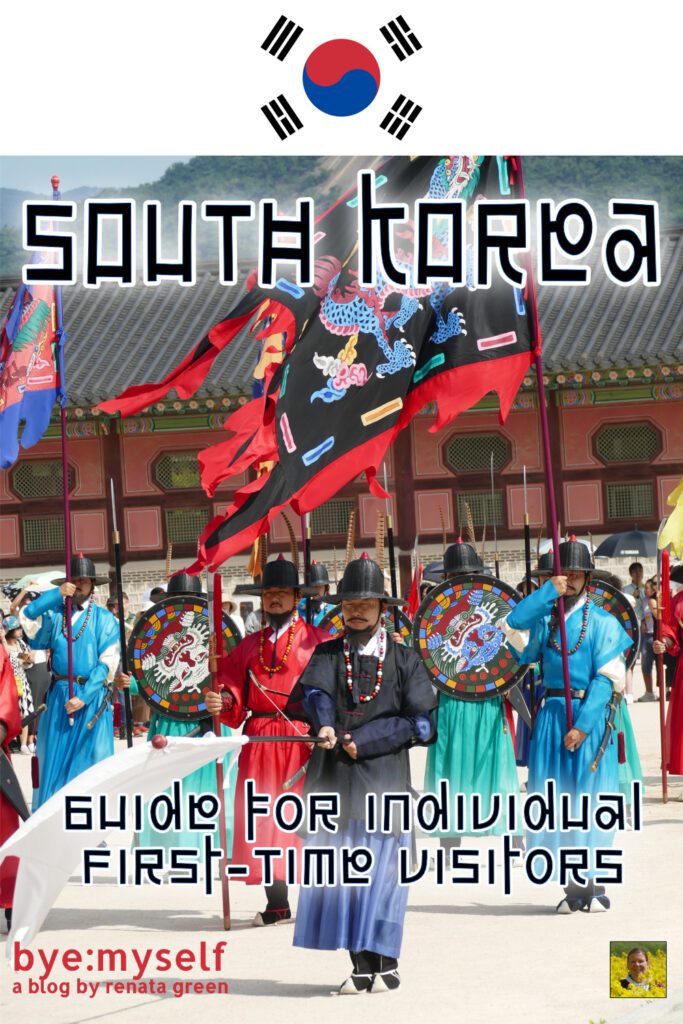

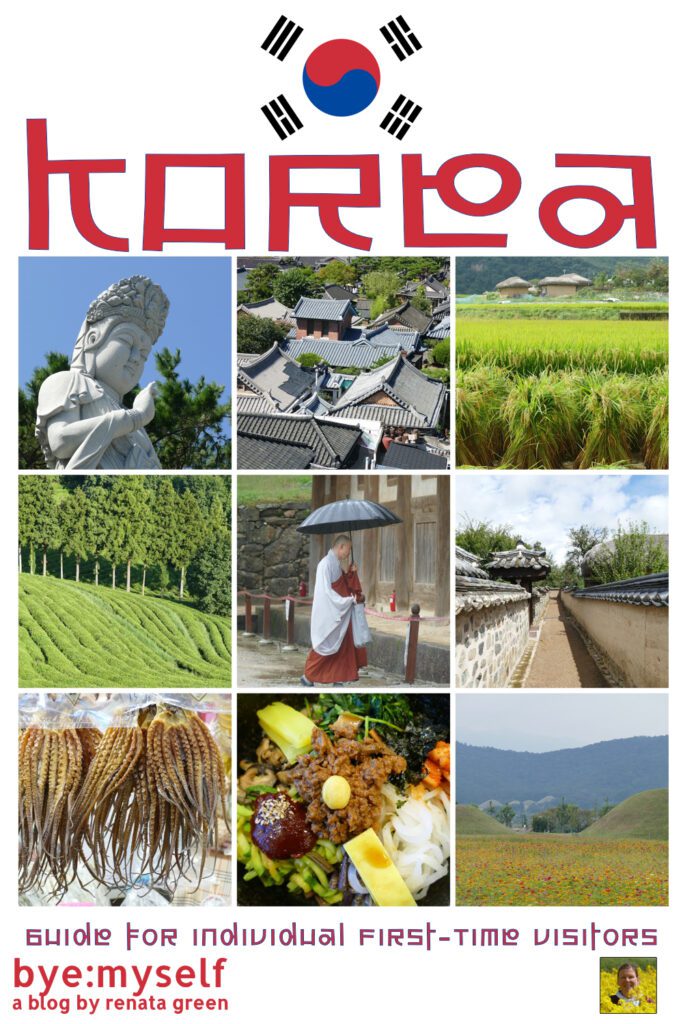
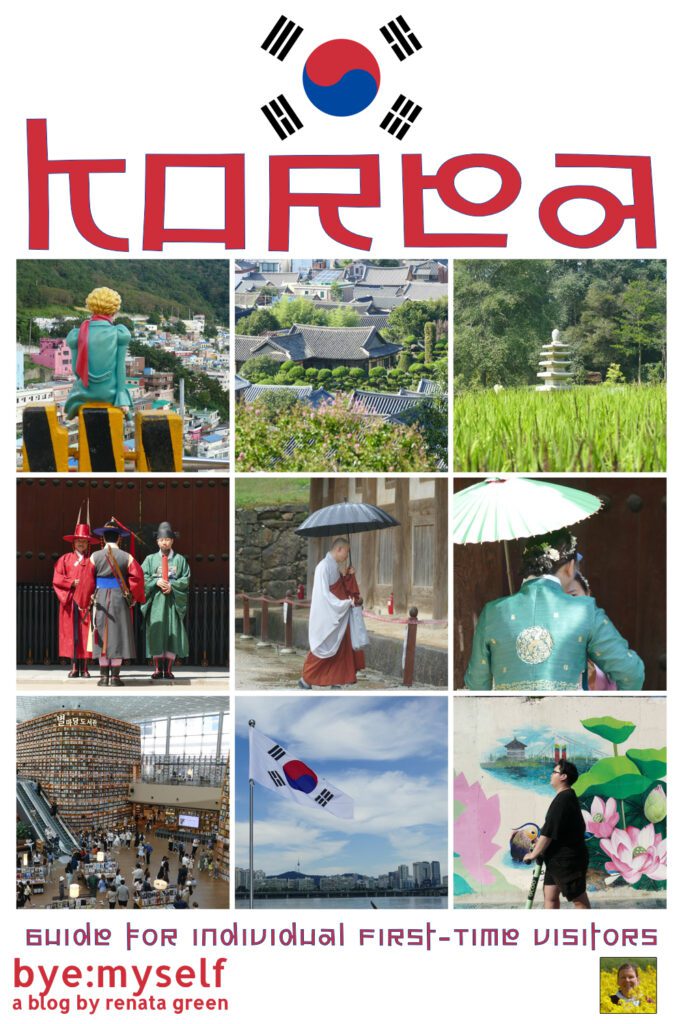
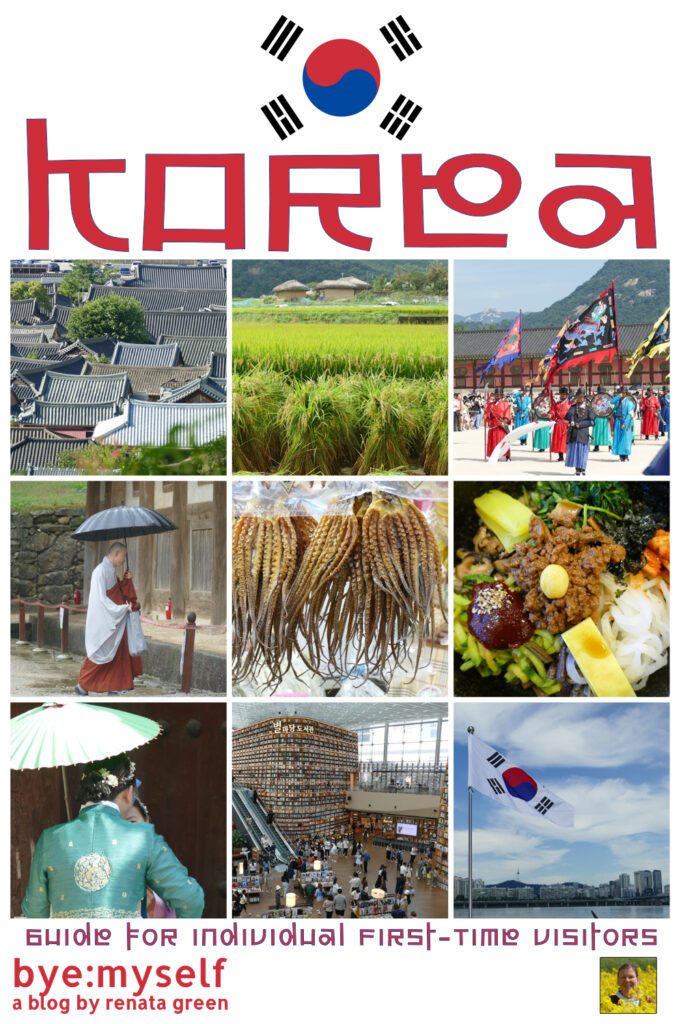
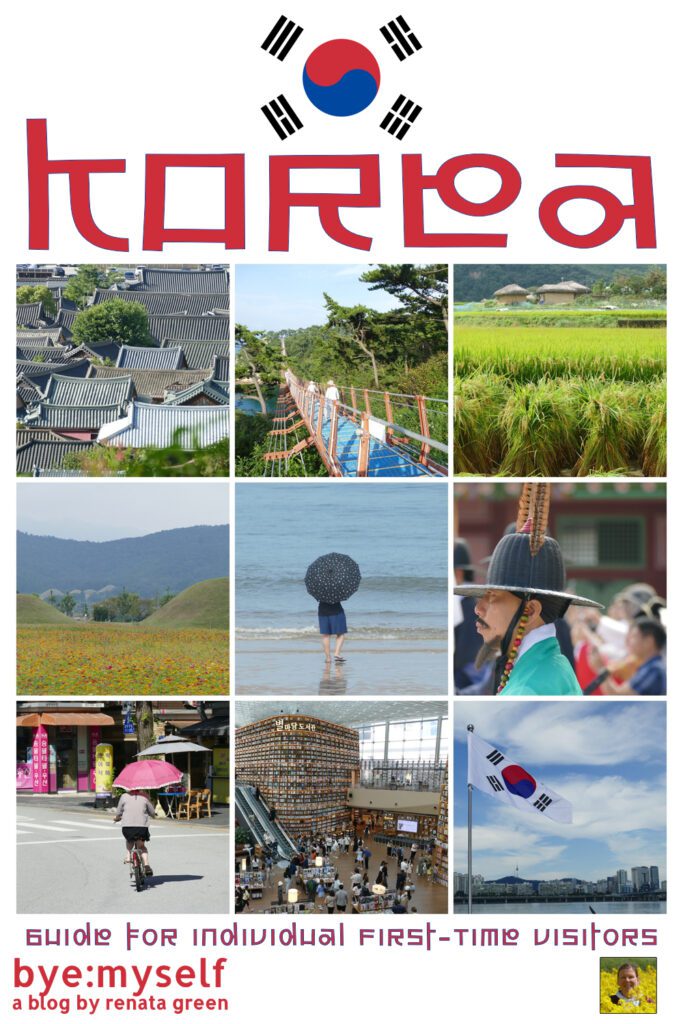
Did You Enjoy This Post? Then You Might Like Also These:
SUKHOTHAI – 200 temples at your choice
An Easy Day Trip to the Hahoe Folk Village from Andong
LOMBOK – Bali ‘s serene alternative
The Ski Instructor of Sri Lanka
PHNOM PENH – a guide to Cambodia’s provincial capital
Culture Villages in Korea: Real People, Real Art
SINGAPORE – first-timers guide to a powerful city-state
Guide to KANDY and a Temple Hike from Embekke to Pilimathalawa
* I received this service free of charge as part of my affiliate cooperation with GetYourGuide for participating in a special promotion. The recommendation of this service is based on my own experience and was in no way influenced by my cooperation partner.
** This is an affiliate link. Hence, If you book through this page, not only do you get the best deal. I also get a small commission that helps me run this blog. Thank you so much for supporting me!

